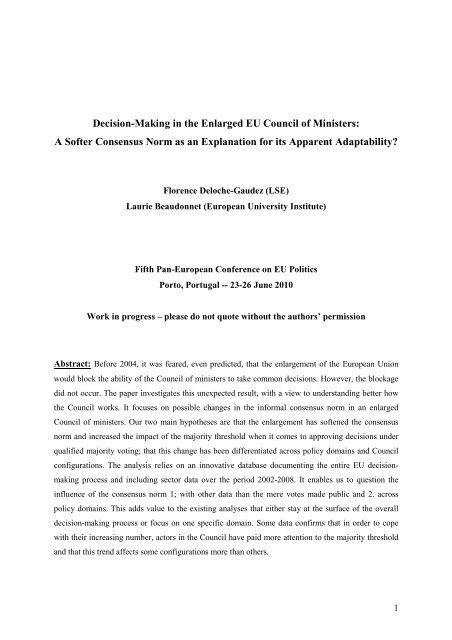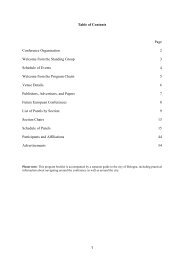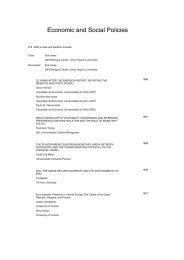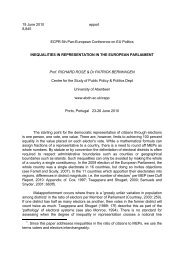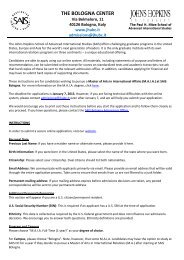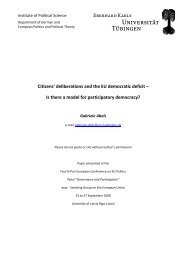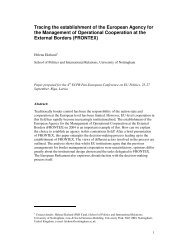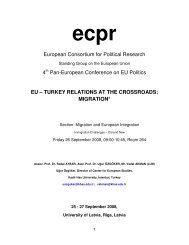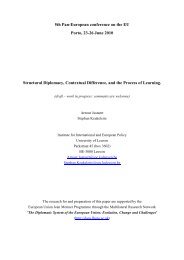Decision-Making in the Enlarged EU Council of Ministers: A Softer ...
Decision-Making in the Enlarged EU Council of Ministers: A Softer ...
Decision-Making in the Enlarged EU Council of Ministers: A Softer ...
Create successful ePaper yourself
Turn your PDF publications into a flip-book with our unique Google optimized e-Paper software.
<strong>Decision</strong>-<strong>Mak<strong>in</strong>g</strong> <strong>in</strong> <strong>the</strong> <strong>Enlarged</strong> <strong>EU</strong> <strong>Council</strong> <strong>of</strong> M<strong>in</strong>isters:<br />
A S<strong>of</strong>ter Consensus Norm as an Explanation for its Apparent Adaptability?<br />
Florence Deloche-Gaudez (LSE)<br />
Laurie Beaudonnet (European University Institute)<br />
Fifth Pan-European Conference on <strong>EU</strong> Politics<br />
Porto, Portugal -- 23-26 June 2010<br />
Work <strong>in</strong> progress – please do not quote without <strong>the</strong> authors’ permission<br />
Abstract: Before 2004, it was feared, even predicted, that <strong>the</strong> enlargement <strong>of</strong> <strong>the</strong> European Union<br />
would block <strong>the</strong> ability <strong>of</strong> <strong>the</strong> <strong>Council</strong> <strong>of</strong> m<strong>in</strong>isters to take common decisions. However, <strong>the</strong> blockage<br />
did not occur. The paper <strong>in</strong>vestigates this unexpected result, with a view to understand<strong>in</strong>g better how<br />
<strong>the</strong> <strong>Council</strong> works. It focuses on possible changes <strong>in</strong> <strong>the</strong> <strong>in</strong>formal consensus norm <strong>in</strong> an enlarged<br />
<strong>Council</strong> <strong>of</strong> m<strong>in</strong>isters. Our two ma<strong>in</strong> hypo<strong>the</strong>ses are that <strong>the</strong> enlargement has s<strong>of</strong>tened <strong>the</strong> consensus<br />
norm and <strong>in</strong>creased <strong>the</strong> impact <strong>of</strong> <strong>the</strong> majority threshold when it comes to approv<strong>in</strong>g decisions under<br />
qualified majority vot<strong>in</strong>g; that this change has been differentiated across policy doma<strong>in</strong>s and <strong>Council</strong><br />
configurations. The analysis relies on an <strong>in</strong>novative database document<strong>in</strong>g <strong>the</strong> entire <strong>EU</strong> decisionmak<strong>in</strong>g<br />
process and <strong>in</strong>clud<strong>in</strong>g sector data over <strong>the</strong> period 2002-2008. It enables us to question <strong>the</strong><br />
<strong>in</strong>fluence <strong>of</strong> <strong>the</strong> consensus norm 1; with o<strong>the</strong>r data than <strong>the</strong> mere votes made public and 2. across<br />
policy doma<strong>in</strong>s. This adds value to <strong>the</strong> exist<strong>in</strong>g analyses that ei<strong>the</strong>r stay at <strong>the</strong> surface <strong>of</strong> <strong>the</strong> overall<br />
decision-mak<strong>in</strong>g process or focus on one specific doma<strong>in</strong>. Some data confirms that <strong>in</strong> order to cope<br />
with <strong>the</strong>ir <strong>in</strong>creas<strong>in</strong>g number, actors <strong>in</strong> <strong>the</strong> <strong>Council</strong> have paid more attention to <strong>the</strong> majority threshold<br />
and that this trend affects some configurations more than o<strong>the</strong>rs.<br />
1
1. Introduction<br />
Before <strong>the</strong> accession <strong>of</strong> ten new member states <strong>in</strong> 2004, many commentators (<strong>in</strong>clud<strong>in</strong>g<br />
academics) predicted that such a ‘big bang’ would block <strong>the</strong> ability <strong>of</strong> <strong>the</strong> European Union to<br />
reach common decisions. This decision-mak<strong>in</strong>g be<strong>in</strong>g at <strong>the</strong> heart <strong>of</strong> European <strong>in</strong>tegration,<br />
<strong>the</strong>se predictions caused some concern. However, at first sight, <strong>the</strong> Union has adapted to <strong>the</strong><br />
recent enlargements surpris<strong>in</strong>gly well. The 2004 enlargement was followed by <strong>the</strong> entry <strong>of</strong><br />
Bulgaria and Romania <strong>in</strong> 2007, which almost doubled <strong>the</strong> number <strong>of</strong> member states.<br />
Meanwhile, a series <strong>of</strong> ‘no’ votes prevented <strong>the</strong> Constitutional Treaty, <strong>the</strong>n <strong>the</strong> Lisbon Treaty<br />
from be<strong>in</strong>g enforced until December 2009. Consequently, <strong>the</strong> implementation <strong>of</strong> provisions<br />
aimed at streaml<strong>in</strong><strong>in</strong>g decision-mak<strong>in</strong>g was postponed accord<strong>in</strong>gly. Never<strong>the</strong>less, quantitative<br />
data shows that <strong>the</strong> enlarged Union has cont<strong>in</strong>ued to take common decisions, almost at <strong>the</strong><br />
same level <strong>in</strong> terms <strong>of</strong> number <strong>of</strong> decisions, and <strong>in</strong>deed more rapidly (cf. figures <strong>in</strong> part 4).<br />
This unexpected result shows that our knowledge <strong>of</strong> how <strong>the</strong> Union works, and how it adapts<br />
to changes such as enlargements, rema<strong>in</strong>s somewhat limited.<br />
This is particularly true when it comes to <strong>the</strong> <strong>Council</strong> <strong>of</strong> M<strong>in</strong>isters. It was widely expected<br />
that <strong>the</strong> 2004 and 2007 enlargements would affect <strong>the</strong> <strong>Council</strong> more than any o<strong>the</strong>r <strong>EU</strong><br />
<strong>in</strong>stitution. The <strong>in</strong>crease <strong>in</strong> <strong>the</strong> number <strong>of</strong> member states immediately translated <strong>in</strong>to a similar<br />
<strong>in</strong>crease <strong>in</strong> <strong>the</strong> number <strong>of</strong> m<strong>in</strong>isters <strong>in</strong> <strong>the</strong> <strong>Council</strong> whereas a key provision <strong>of</strong> <strong>the</strong><br />
Constitutional treaty relat<strong>in</strong>g to <strong>the</strong> <strong>Council</strong>’s decision-mak<strong>in</strong>g, <strong>the</strong> new double majority<br />
decision rule, could not entry <strong>in</strong>to force. This rule was <strong>the</strong>n <strong>in</strong>cluded <strong>in</strong> <strong>the</strong> Lisbon Treaty on<br />
<strong>the</strong> condition that its implementation would be postponed until 2014. It was <strong>the</strong>refore<br />
assumed that <strong>the</strong> <strong>Council</strong> would suffer from <strong>the</strong> drawback <strong>of</strong> <strong>in</strong>clud<strong>in</strong>g more numerous and<br />
more heterogeneous members, determ<strong>in</strong>ed to defend national <strong>in</strong>terests while be<strong>in</strong>g obliged to<br />
reach common decisions under <strong>the</strong> current high thresholds <strong>of</strong> qualified majority vot<strong>in</strong>g or,<br />
worse, under <strong>the</strong> unanimity rule. Some alarm<strong>in</strong>g scenarios, <strong>of</strong>ten based on quantitative<br />
modell<strong>in</strong>g, <strong>in</strong>dicated that, under <strong>the</strong> provisions <strong>of</strong> <strong>the</strong> Nice Treaty, <strong>the</strong> probability <strong>of</strong> form<strong>in</strong>g<br />
w<strong>in</strong>n<strong>in</strong>g coalitions was expected to be very unlikely (Tsebelis, 2005). However, <strong>the</strong> predicted<br />
blockage did not occur (Best, Christiansen, Settembri, 2008; Dehousse, Deloche-Gaudez,<br />
Duhamel, 2006; Hagemann, De Clerck-Sachsse, 2007; Wallace, 2007).<br />
This unexpected adaptability confirms that more than fifty years after <strong>the</strong> treaty <strong>of</strong> Rome, we<br />
still do not fully understand how common decisions are reached <strong>in</strong> this <strong>in</strong>stitution.<br />
2
Admittedly, <strong>the</strong> decision-mak<strong>in</strong>g process <strong>in</strong> <strong>the</strong> <strong>Council</strong> is not easy to evaluate as, despite <strong>the</strong><br />
transparency provisions, most <strong>of</strong> it still occurs beh<strong>in</strong>d closed doors. As a result, <strong>the</strong> key word<br />
‘consensus’ used s<strong>in</strong>ce <strong>the</strong> beg<strong>in</strong>n<strong>in</strong>g <strong>of</strong> European <strong>in</strong>tegration (Haas, 1958), up until now<br />
(Naur<strong>in</strong>, Wallace, 2008), to describe <strong>the</strong> <strong>Council</strong> decision-mak<strong>in</strong>g process still leaves many<br />
questions open. In particular, as more and more decisions are subject to <strong>the</strong> rule <strong>of</strong> qualified<br />
majority vot<strong>in</strong>g (QMV) and could legally be adopted by votes, why <strong>in</strong> most cases do all<br />
m<strong>in</strong>isters seem to rally to <strong>the</strong> decision made and approve it by ‘consensus’? Is <strong>the</strong> <strong>in</strong>formal<br />
norm <strong>of</strong> <strong>the</strong> consensus strong enough to neutralize <strong>the</strong> effect <strong>of</strong> formal vot<strong>in</strong>g rules and rally<br />
opponents (Heisenberg, 2005)? Or could <strong>the</strong> few votes made public mask <strong>the</strong> fact that <strong>the</strong><br />
majority threshold plays a more frequent role than usually assumed (Novak, 2009)?<br />
The aim <strong>of</strong> this paper is to contribute to a better understand<strong>in</strong>g <strong>of</strong> <strong>the</strong> enlarged <strong>Council</strong>’s<br />
function<strong>in</strong>g by focus<strong>in</strong>g on its apparent adaptability, which, <strong>in</strong> our view, has not yet been fully<br />
<strong>in</strong>vestigated. It is structured as follows. First we <strong>in</strong>vestigate why, from a <strong>the</strong>oretical po<strong>in</strong>t <strong>of</strong><br />
view, scrut<strong>in</strong>iz<strong>in</strong>g changes <strong>in</strong> <strong>the</strong> <strong>in</strong>formal consensus norm with<strong>in</strong> <strong>the</strong> <strong>Council</strong> as a whole, and<br />
across its different configurations, is fruitful and how it could expla<strong>in</strong> for <strong>the</strong> ra<strong>the</strong>r stable<br />
legislative output <strong>of</strong> <strong>the</strong> <strong>Council</strong>. We <strong>the</strong>n describe our methodological choices and provide<br />
details on <strong>the</strong> <strong>in</strong>novative dataset that we are us<strong>in</strong>g to exam<strong>in</strong>e <strong>the</strong> respective <strong>in</strong>fluence <strong>of</strong> <strong>the</strong><br />
consensus norm and <strong>the</strong> majority threshold when it comes to tak<strong>in</strong>g common decisions.<br />
F<strong>in</strong>ally, we provide and discuss results from our analysis.<br />
2. Theoretical argument<br />
a) The <strong>in</strong>fluence <strong>of</strong> <strong>the</strong> consensus norm with<strong>in</strong> <strong>the</strong> <strong>Council</strong> <strong>of</strong> <strong>the</strong> <strong>EU</strong><br />
A dom<strong>in</strong>ant narrative is that, <strong>in</strong> <strong>the</strong> <strong>EU</strong> <strong>Council</strong>, actors try and reach common decisions by<br />
consensus, without vot<strong>in</strong>g, even when <strong>the</strong>y could decide by majority and outvote m<strong>in</strong>orities<br />
(Heisenberg, 2005; Lewis, 2008). Accord<strong>in</strong>g to this narrative, <strong>the</strong> members <strong>of</strong> <strong>the</strong> <strong>Council</strong> are<br />
will<strong>in</strong>g to cont<strong>in</strong>ue discussions until everybody is ‘on board’. Such a practice has different<br />
advantages. In particular, it streng<strong>the</strong>ns <strong>the</strong> legitimacy <strong>of</strong> <strong>EU</strong> acts and favors <strong>the</strong>ir<br />
implementation (that relies on national governments and could be impeded if too many<br />
countries were outvoted).<br />
3
This picture seems to be confirmed by <strong>the</strong> small number <strong>of</strong> no votes and abstentions. S<strong>in</strong>ce<br />
1999, <strong>the</strong> number <strong>of</strong> legislative acts ruled by qualified majority vot<strong>in</strong>g (QMV) and hav<strong>in</strong>g<br />
given rise to public votes have never represented more than 30% <strong>of</strong> <strong>the</strong> legislative acts ruled<br />
by QMV (Dehousse, Deloche-Gaudez, 2009). However, this figure also shows that, <strong>in</strong> some<br />
cases, m<strong>in</strong>isters do vote, whereas <strong>the</strong> idea <strong>of</strong> consensus excludes any votes (Urfal<strong>in</strong>o, 2006).<br />
Given <strong>the</strong>ir small number, <strong>the</strong>se votes are usually considered as a ‘last resort’, used only to<br />
overcome situations <strong>of</strong> stalemate <strong>in</strong> <strong>the</strong> <strong>Council</strong> <strong>of</strong> m<strong>in</strong>isters, when consensus cannot be<br />
reached because <strong>of</strong> a very few number <strong>of</strong> <strong>in</strong>flexible opponents. The consensus-seek<strong>in</strong>g norm<br />
is <strong>the</strong>refore sometimes put aside and replaced with ‘last resort’ votes.<br />
In <strong>the</strong> literature, <strong>the</strong>re are o<strong>the</strong>r accounts <strong>of</strong> decision-mak<strong>in</strong>g <strong>in</strong> <strong>the</strong> <strong>Council</strong> imply<strong>in</strong>g that<br />
consensus coexists with votes more <strong>of</strong>ten. Accord<strong>in</strong>g to <strong>the</strong>m, consensual decisions are<br />
reached ‘<strong>in</strong> <strong>the</strong> shadow <strong>of</strong> <strong>the</strong> vote’ (Golub, 1999). In o<strong>the</strong>r words, consensual decisions can<br />
be reached because m<strong>in</strong>isters are aware that, under QMV, votes can be cast at any moment.<br />
Know<strong>in</strong>g that <strong>the</strong>y can be outvoted, <strong>the</strong>y are more <strong>in</strong>cl<strong>in</strong>ed to compromises. This is <strong>the</strong> reason<br />
why <strong>the</strong> idea <strong>of</strong> ‘implicit vot<strong>in</strong>g’ is also present <strong>in</strong> <strong>the</strong> literature. However, it is difficult to<br />
f<strong>in</strong>d firm conclusions on <strong>the</strong> exact scope and <strong>in</strong>fluence <strong>of</strong> this ‘shadow <strong>of</strong> <strong>the</strong> vote’<br />
(Hageman, 2009). It is even argued that, <strong>in</strong> some configurations <strong>of</strong> <strong>the</strong> <strong>Council</strong>, <strong>the</strong> absence <strong>of</strong><br />
systematic explicit disagreement masks a permanent ‘count<strong>in</strong>g practice’ that can be<br />
summarized as follows: votes <strong>of</strong> countries <strong>in</strong> favour <strong>of</strong> <strong>the</strong> proposal on <strong>the</strong> table are constantly<br />
be<strong>in</strong>g counted; <strong>the</strong> discussions are rapidly ended by <strong>the</strong> presidency once <strong>the</strong> majority<br />
threshold is reached; <strong>the</strong> states <strong>in</strong> <strong>the</strong> m<strong>in</strong>ority have <strong>the</strong>n <strong>the</strong> opportunity to make <strong>the</strong>ir<br />
opposition public or not (Novak, 2009). Consequently, by look<strong>in</strong>g only at votes made public,<br />
one might overestimate <strong>the</strong> consensus <strong>in</strong>fluence.<br />
However a question rema<strong>in</strong>s: why so few m<strong>in</strong>isters make <strong>the</strong>ir opposition public? This<br />
question leads us to dist<strong>in</strong>guish two different moments when <strong>the</strong> consensus norm is likely to<br />
<strong>in</strong>fluence behaviour: when it comes to tak<strong>in</strong>g common decisions (phase 1) and, <strong>the</strong>n, when it<br />
comes to mak<strong>in</strong>g votes public (phase 2). In <strong>the</strong> first case, it encourages m<strong>in</strong>isters not to vote,<br />
and <strong>in</strong> <strong>the</strong> second case, not to reveal <strong>the</strong>ir opposition. The <strong>in</strong>fluence <strong>of</strong> <strong>the</strong> consensus norm is<br />
not necessarily <strong>the</strong> same dur<strong>in</strong>g <strong>the</strong> two phases. Actually, <strong>the</strong> small number <strong>of</strong> public votes<br />
seems to suggest that this <strong>in</strong>formal norm rema<strong>in</strong>s strong <strong>in</strong> <strong>the</strong> second phase. But, here, we<br />
question <strong>the</strong> <strong>in</strong>fluence <strong>of</strong> <strong>the</strong> consensus norm <strong>in</strong> <strong>the</strong> first phase, when decisions are taken.<br />
4
Hypo<strong>the</strong>ses: a less <strong>in</strong>fluential consensus norm s<strong>in</strong>ce enlargement?<br />
Our basic assumption is that, <strong>in</strong> <strong>the</strong> absence <strong>of</strong> any new treaty from 2004 until 2009, and<br />
consequently <strong>of</strong> any change <strong>in</strong> formal decision rules 1 , some <strong>in</strong>formal rules had to change to<br />
enable <strong>the</strong> <strong>Council</strong> to cope with <strong>the</strong> <strong>in</strong>creas<strong>in</strong>g number <strong>of</strong> its members and to keep deliver<strong>in</strong>g<br />
common decisions. More precisely, <strong>the</strong> m<strong>in</strong>isters have paid less attention to <strong>the</strong> requirements<br />
<strong>of</strong> <strong>the</strong> <strong>in</strong>formal consensus norm, and thus have given more weight to formal rules. Under<br />
QMV, once <strong>the</strong> majority threshold reached, <strong>the</strong>y have been <strong>in</strong>cl<strong>in</strong>ed to put an end to <strong>the</strong><br />
discussions more <strong>of</strong>ten and/or more rapidly. This supposition is <strong>in</strong> l<strong>in</strong>e with <strong>the</strong> constructivist<br />
and <strong>in</strong>stitutionalist argument: what matters is not only <strong>the</strong> formal rules, but also, perhaps more<br />
importantly, <strong>the</strong> way <strong>the</strong>y are <strong>in</strong>terpreted and implemented by <strong>the</strong> various actors <strong>in</strong>volved<br />
(Peterson, Shackleton, 2006; Pollack, 2005).<br />
As mentioned before, this assumption is not confirmed by <strong>the</strong> percentage <strong>of</strong> votes made<br />
public, which that has somewhat decl<strong>in</strong>ed s<strong>in</strong>ce enlargement (see figures <strong>in</strong> part 4). However,<br />
it must be emphasized that <strong>the</strong> votes made public are ‘odd’ votes and that <strong>the</strong>y are likely to<br />
give a restricted, possibly distorted, picture <strong>of</strong> reality (Dehousse, Deloche-Gaudez, Duhamel,<br />
2006; Heisenberg, 2008). They only account for votes recorded dur<strong>in</strong>g <strong>the</strong> f<strong>in</strong>al adoption <strong>of</strong><br />
legislative acts. Consequently, <strong>the</strong>y are made public once <strong>the</strong> decision is taken, if <strong>the</strong> m<strong>in</strong>ority<br />
states wish to express <strong>the</strong>ir opposition through a no vote or an abstention. But <strong>the</strong>y cannot<br />
prevent a decision from be<strong>in</strong>g taken. On <strong>the</strong> contrary, votes that prevent a decision from be<strong>in</strong>g<br />
taken are not made public: if <strong>the</strong> number <strong>of</strong> oppos<strong>in</strong>g votes reaches <strong>the</strong> block<strong>in</strong>g m<strong>in</strong>ority, <strong>the</strong><br />
act is simply not passed. It can thus be argued that <strong>the</strong>se votes are likely to reflect domestic<br />
concerns, probably more than <strong>the</strong> <strong>Council</strong>’s vot<strong>in</strong>g practice. For <strong>in</strong>stance, <strong>the</strong> Danish<br />
government is one <strong>of</strong> <strong>the</strong> governments that give most <strong>of</strong>ten public pro<strong>of</strong> <strong>of</strong> opposition because<br />
its positions <strong>in</strong> <strong>the</strong> <strong>Council</strong> are agreed upon with <strong>the</strong> Danish Parliament beforehand. When it<br />
fails to w<strong>in</strong> <strong>the</strong> case, mak<strong>in</strong>g its opposition public is a means to signal its Parliament that it<br />
did its utmost to advocate <strong>the</strong>ir preferences.<br />
This is why, <strong>in</strong> our view, to be able to grasp <strong>the</strong> reality <strong>of</strong> vot<strong>in</strong>g practice, or even more<br />
difficult, <strong>the</strong> <strong>in</strong>fluence <strong>of</strong> <strong>the</strong> majority threshold <strong>in</strong> <strong>the</strong> <strong>Council</strong>, we should not adhere to this<br />
mere data but we should resort to complementary questions, data and hypo<strong>the</strong>ses. We should<br />
first compare <strong>the</strong> legislative output <strong>of</strong> <strong>the</strong> <strong>Council</strong> accord<strong>in</strong>g to two different formal rules,<br />
1 The ma<strong>in</strong> exception is <strong>the</strong> application s<strong>in</strong>ce 1 January 2005 <strong>of</strong> codecision and QMV to most measures<br />
concern<strong>in</strong>g asylum, immigration and <strong>the</strong> movement <strong>of</strong> persons (except legal immigration and family laws) <strong>in</strong> <strong>the</strong><br />
area <strong>of</strong> security and justice,) (Best, Christiansen, Settembri, 2008).<br />
5
unanimity and QMV. Our first hypo<strong>the</strong>sis is that, s<strong>in</strong>ce enlargement, <strong>the</strong> def<strong>in</strong>itive legislative<br />
acts under QMV have become comparatively more numerous and faster to adopt than <strong>the</strong><br />
ones ruled by <strong>the</strong> unanimity rule (hypo<strong>the</strong>sis 1a). It could mean that <strong>the</strong> decision-mak<strong>in</strong>g<br />
process under QMV tends to differ from <strong>the</strong> one occurr<strong>in</strong>g when unanimous decisions are<br />
required. In o<strong>the</strong>r words, <strong>the</strong> <strong>in</strong>fluence <strong>of</strong> <strong>the</strong> majority threshold could compete more and<br />
more with <strong>the</strong> consensus norm.<br />
Secondly, to <strong>in</strong>vestigate possible changes <strong>in</strong> <strong>the</strong> effects <strong>of</strong> <strong>the</strong> consensus norm, we have to<br />
look at <strong>the</strong> decision-mak<strong>in</strong>g duration under QMV when acts have given rise to public votes. A<br />
reduction <strong>in</strong> this duration could mean that consensual decisions are not sought for as long as it<br />
used to be <strong>the</strong> case before enlargement. When <strong>the</strong> majority is reached, <strong>the</strong> presidency might<br />
suggest to end negotiations faster, allow<strong>in</strong>g for <strong>the</strong> act to be adopted even if a full consensus<br />
is not reached - <strong>the</strong> states <strong>in</strong> <strong>the</strong> m<strong>in</strong>ority hav<strong>in</strong>g <strong>the</strong>n <strong>the</strong> opportunity to make <strong>the</strong>ir<br />
opposition public or not. Our second hypo<strong>the</strong>sis is that this duration has decreased s<strong>in</strong>ce<br />
enlargement (hypo<strong>the</strong>sis 1b).<br />
Changes <strong>in</strong> <strong>the</strong> size <strong>of</strong> m<strong>in</strong>orities us<strong>in</strong>g votes public can also give <strong>in</strong>dications <strong>of</strong> how long<br />
m<strong>in</strong>isters negotiate. From 1999 to 2004, most <strong>of</strong> <strong>the</strong>se m<strong>in</strong>orities have comprised one member<br />
state only (Hayes-Renshaw, Van Aken, Wallace, 2006). It is <strong>in</strong> l<strong>in</strong>e with <strong>the</strong> idea that<br />
discussions <strong>in</strong> <strong>the</strong> <strong>Council</strong> are pursued as long as possible and votes used as a last resort to<br />
neutralize a last recalcitrant state. We expect that, after <strong>the</strong> 2004 enlargement, <strong>the</strong> percentage<br />
<strong>of</strong> <strong>the</strong>se one-state m<strong>in</strong>ority coalitions should decrease. It could mean that m<strong>in</strong>isters are ready<br />
to take <strong>the</strong> majority threshold <strong>in</strong>to account and end discussions even if <strong>the</strong>re are several<br />
oppos<strong>in</strong>g countries. Admittedly, <strong>the</strong> <strong>in</strong>crease <strong>in</strong> <strong>the</strong> number <strong>of</strong> member states could<br />
automatically produce larger m<strong>in</strong>ority coalitions compris<strong>in</strong>g more and more states. Also, <strong>the</strong><br />
size <strong>of</strong> m<strong>in</strong>ority coalitions could be a result <strong>of</strong> <strong>the</strong> <strong>in</strong>fluence <strong>of</strong> <strong>the</strong> consensus norm once <strong>the</strong><br />
decision is taken, when it comes to reveal<strong>in</strong>g one’s opposition (<strong>in</strong> <strong>the</strong> phase 2, see above).<br />
Never<strong>the</strong>less, <strong>the</strong> decrease <strong>in</strong> <strong>the</strong> percentage <strong>of</strong> one-state m<strong>in</strong>orities could also signal a change<br />
<strong>in</strong> <strong>the</strong> way discussions are held and ended by <strong>the</strong> presidency (<strong>in</strong> phase 1).<br />
These first three hypo<strong>the</strong>ses deal with <strong>the</strong> <strong>Council</strong> as a whole. Actually, <strong>the</strong> m<strong>in</strong>isters meet <strong>in</strong><br />
specialized configurations (currently <strong>in</strong> a total <strong>of</strong> n<strong>in</strong>e) to deal with sector-specific issues,<br />
such as agriculture and fisheries, or competition. Given that <strong>the</strong> different configurations<br />
ga<strong>the</strong>r different m<strong>in</strong>isters, who deal with different matters and face different requirements as<br />
well as various deadl<strong>in</strong>es, our hypo<strong>the</strong>sis is that <strong>the</strong>re is a differentiation across<br />
6
configurations, notably <strong>in</strong> terms <strong>of</strong> output and decision-mak<strong>in</strong>g duration, which also affects<br />
<strong>the</strong> <strong>in</strong>fluence <strong>of</strong> <strong>the</strong> consensus norm (hypo<strong>the</strong>sis 2a). In o<strong>the</strong>r words, <strong>in</strong> some configurations,<br />
m<strong>in</strong>isters pay more attention to <strong>the</strong> majority threshold, and are more likely to end negotiations<br />
once it is reached, than <strong>in</strong> o<strong>the</strong>rs.<br />
Our last hypo<strong>the</strong>sis is that changes affect<strong>in</strong>g <strong>the</strong> consensus norm <strong>in</strong>fluence are differentiated<br />
across configurations as well and that <strong>the</strong>y are more significant <strong>in</strong> some <strong>of</strong> <strong>the</strong>m. More<br />
precisely, we expect configurations used to tak<strong>in</strong>g <strong>the</strong> majority threshold <strong>in</strong>to account, to pay<br />
even more attention to it after enlargement, and configurations where <strong>the</strong> consensus norm is<br />
more <strong>in</strong>fluential to f<strong>in</strong>d it difficult to get out <strong>of</strong> <strong>the</strong> habit <strong>of</strong> reach<strong>in</strong>g consensual decisions<br />
(hypo<strong>the</strong>sis 2b). Consequently, if our paper questions <strong>the</strong> idea <strong>of</strong> a ‘path dependence’ by<br />
putt<strong>in</strong>g forward hypo<strong>the</strong>ses about possible changes to <strong>in</strong>formal norms, we go back to this idea<br />
when it comes to configurations.<br />
This sector approach adds value to <strong>the</strong> exist<strong>in</strong>g analyses that ei<strong>the</strong>r stay at <strong>the</strong> surface <strong>of</strong> <strong>the</strong><br />
overall decision-mak<strong>in</strong>g process or focus on one specific doma<strong>in</strong>. It aims at improv<strong>in</strong>g our<br />
knowledge on sector specificities, whose limitations have been emphasized by some scholars<br />
(Golub, 2007; Hagemann, 2008, 2009).<br />
Table 1. Hypo<strong>the</strong>ses summary<br />
H1a: <strong>Decision</strong>-mak<strong>in</strong>g processes under unanimity and Qualified<br />
H1: The enlargement<br />
has s<strong>of</strong>tened <strong>the</strong><br />
consensus norm<br />
<strong>in</strong>fluence<br />
H2: The impact <strong>of</strong><br />
this change is<br />
differentiated across<br />
configurations<br />
Majority Vot<strong>in</strong>g rule have diverged<br />
H1b: Under QMV, discussions have ended sooner once <strong>the</strong><br />
majority threshold is reached<br />
duration <strong>in</strong> case <strong>of</strong> public votes has decreased<br />
share <strong>of</strong> one-state coalitions has decreased<br />
H2a: A sector differentiation affects output and duration as well as<br />
vot<strong>in</strong>g practice<br />
H2b: Changes <strong>in</strong> <strong>the</strong> consensus norm <strong>in</strong>fluence are differentiated<br />
across configurations<br />
7
3. Research design<br />
a) Data<br />
In order to test <strong>the</strong>se hypo<strong>the</strong>ses, we use a dataset <strong>of</strong> all def<strong>in</strong>itive legislative acts adopted by<br />
<strong>the</strong> <strong>Council</strong> from January 2002 to December 2008 (more than 1300 cases). This dataset is<br />
built with<strong>in</strong> Sciences Po’s Observatory <strong>of</strong> European Institutions. It is unique as, first, it<br />
documents <strong>the</strong> whole process <strong>of</strong> each legislative act and <strong>in</strong>cludes data on various aspects <strong>of</strong><br />
decision-mak<strong>in</strong>g, such as duration, votes made public, <strong>the</strong> DG <strong>in</strong> charge <strong>of</strong> <strong>the</strong> proposal, <strong>the</strong><br />
number <strong>of</strong> read<strong>in</strong>gs with<strong>in</strong> <strong>the</strong> codecision procedure or <strong>the</strong> number <strong>of</strong> B/A po<strong>in</strong>ts par act (see<br />
<strong>the</strong> list <strong>of</strong> variables <strong>in</strong> Annex 1). Second, it <strong>in</strong>cludes sector data drawn from <strong>the</strong> Directory <strong>of</strong><br />
Community Legislation <strong>in</strong> Force, which allows for <strong>in</strong>novative policy doma<strong>in</strong> analyses.<br />
The dataset is based on <strong>the</strong> ‘def<strong>in</strong>itive legislative acts’ adopted by <strong>the</strong> <strong>Council</strong>, for two<br />
reasons: 1) <strong>the</strong>y are presumably <strong>the</strong> most important acts; 2) <strong>the</strong>y are <strong>the</strong> only acts for which<br />
votes cast by member states dur<strong>in</strong>g <strong>the</strong>ir f<strong>in</strong>al adoption are systematically made public. Even if<br />
<strong>the</strong> votes made public might not reveal <strong>the</strong> actual level <strong>of</strong> opposition <strong>in</strong> <strong>the</strong> <strong>Council</strong> (see<br />
above), this data is crucial for our analysis as it allows for o<strong>the</strong>r calculations such as <strong>the</strong><br />
decision-mak<strong>in</strong>g duration when votes are or are not made public.<br />
The legislative acts <strong>in</strong>cluded <strong>in</strong> <strong>the</strong> dataset are drawn from <strong>the</strong> Monthly Summaries <strong>of</strong> <strong>Council</strong><br />
acts that are available on <strong>the</strong> <strong>Council</strong> website 2 . These summaries list all legislative acts<br />
adopted each month, as well as <strong>the</strong> votes made public and <strong>the</strong> vot<strong>in</strong>g rule. As mentioned <strong>in</strong> <strong>the</strong><br />
previous part, <strong>the</strong> latter is essential if we want to compare <strong>the</strong> <strong>Council</strong>’s legislative output<br />
ruled by QMV / unanimity and assess <strong>the</strong> impact <strong>of</strong> <strong>the</strong>se formal rules.<br />
The database also conta<strong>in</strong>s data related to <strong>the</strong> Commission and <strong>the</strong> EP, for <strong>the</strong>oretical and<br />
practical reasons. As o<strong>the</strong>r academics argue, it appears ‘impossible to tell <strong>the</strong> story <strong>of</strong> <strong>Council</strong><br />
decision-mak<strong>in</strong>g without reference to o<strong>the</strong>r <strong>in</strong>stitutional actors (notably <strong>the</strong> EP and <strong>the</strong><br />
Commission)’ (Pollack, Shaffer, 2008). From an empirical perspective, hav<strong>in</strong>g data on <strong>the</strong><br />
transmission <strong>of</strong> Commission proposals to <strong>the</strong> <strong>Council</strong> and <strong>the</strong>ir adoption date by <strong>the</strong> <strong>Council</strong><br />
allows for calculations <strong>of</strong> decision-mak<strong>in</strong>g duration. As for data on <strong>the</strong> EP, it notably relates<br />
to <strong>the</strong> codecision procedure. It enables to differentiate acts adopted by <strong>the</strong> <strong>Council</strong> under<br />
QMV, with<strong>in</strong> and outside <strong>the</strong> codecision procedure.<br />
2 http://www.consilium.europa.eu/showPage.aspx?id=551&lang=EN<br />
8
Build<strong>in</strong>g such a dataset implies ga<strong>the</strong>r<strong>in</strong>g data from four different onl<strong>in</strong>e sources: not only <strong>the</strong><br />
monthly summaries <strong>of</strong> <strong>Council</strong> acts, but also <strong>the</strong> Pre-Lex database on <strong>in</strong>ter-<strong>in</strong>stitutional<br />
procedures, <strong>the</strong> EP Legislative Observatory OEIL and <strong>the</strong> Eur-Lex Database. 3 Rely<strong>in</strong>g on<br />
various sources has <strong>the</strong> advantage <strong>of</strong> permitt<strong>in</strong>g cross check<strong>in</strong>g. This has <strong>in</strong>deed revealed<br />
errors or <strong>in</strong>consistencies, notably because <strong>of</strong> a lack <strong>of</strong> coord<strong>in</strong>ation between <strong>EU</strong> <strong>in</strong>stitutions,<br />
and has led us to establish systematic validation rules.<br />
Data covers seven years (2002-2008), which allows us to make comparisons before/after<br />
enlargement and to rely on a significant period <strong>of</strong> time after <strong>the</strong> 2004 enlargement. However,<br />
<strong>the</strong> shorter period <strong>of</strong> time before enlargement (Jan 2002 – April 2004) could be mislead<strong>in</strong>g.<br />
Regard<strong>in</strong>g durations, as <strong>EU</strong> actors were will<strong>in</strong>g to clear <strong>the</strong> table <strong>of</strong> acts that have been<br />
bogged <strong>in</strong> <strong>the</strong> decision-mak<strong>in</strong>g process for a long time, it could lead to overestimate <strong>the</strong><br />
decision-mak<strong>in</strong>g duration before enlargement and conclude, wrongly, that <strong>the</strong> <strong>Council</strong> has<br />
been faster <strong>in</strong> its decision-mak<strong>in</strong>g s<strong>in</strong>ce May 2004. Regard<strong>in</strong>g legislative output, many acts<br />
were adopted <strong>in</strong> <strong>the</strong> months preced<strong>in</strong>g <strong>the</strong> enlargement, for fear that <strong>the</strong> <strong>in</strong>crease <strong>in</strong> <strong>the</strong><br />
number <strong>of</strong> <strong>EU</strong> actors should make it impossible to approve <strong>the</strong>m later. This could lead to<br />
overestimate <strong>the</strong> decl<strong>in</strong>e <strong>in</strong> <strong>the</strong> legislative output observed <strong>in</strong> 2005. Our <strong>in</strong>tention is to <strong>in</strong>clude<br />
<strong>the</strong> years 2000 and 2001 <strong>in</strong> <strong>the</strong> database by <strong>the</strong> end <strong>of</strong> this year and to test aga<strong>in</strong> our<br />
hypo<strong>the</strong>ses. Meanwhile, <strong>the</strong>se remarks should be kept <strong>in</strong> m<strong>in</strong>d when it comes to analyz<strong>in</strong>g <strong>the</strong><br />
data.<br />
b) Dependent variables<br />
To test our hypo<strong>the</strong>ses we rely on two measures: <strong>the</strong> number <strong>of</strong> legislative acts adopted by <strong>the</strong><br />
<strong>Council</strong>, and <strong>the</strong> duration <strong>of</strong> decision-mak<strong>in</strong>g. The duration variable measures <strong>the</strong> number <strong>of</strong><br />
days from <strong>the</strong> date a Commission’s proposal is transmitted to <strong>the</strong> <strong>Council</strong> to its adoption.<br />
Depend<strong>in</strong>g on <strong>the</strong> hypo<strong>the</strong>sis, <strong>the</strong> group <strong>of</strong> acts under <strong>in</strong>vestigation slightly varies.<br />
To test our first hypo<strong>the</strong>sis (H1a) on <strong>the</strong> <strong>in</strong>creas<strong>in</strong>g difficulty <strong>of</strong> reach<strong>in</strong>g common decisions<br />
under unanimity rule <strong>in</strong> an enlarged <strong>Council</strong> <strong>of</strong> m<strong>in</strong>isters, we first study <strong>the</strong> changes <strong>in</strong><br />
volume for acts adopted under <strong>the</strong> unanimity rule and under QMV. We <strong>the</strong>n use <strong>the</strong> duration<br />
<strong>of</strong> decision-mak<strong>in</strong>g under <strong>the</strong>se two rules. Among QMV acts, we dist<strong>in</strong>guish acts that are<br />
adopted with<strong>in</strong> <strong>the</strong> codecision procedure from those that are not. As this procedure contributes<br />
3 Sources: Prelex database: http://ec.europa.eu/prelex/apcnet.cfm?CL=en<br />
OEIL database: http://www.europarl.europa.eu/oeil/<strong>in</strong>dex.jsp<br />
Eur-lex database: http://eur-lex.europa.eu/en/<strong>in</strong>dex.htm<br />
9
to <strong>in</strong>crease <strong>the</strong> decision-mak<strong>in</strong>g duration, compar<strong>in</strong>g acts adopted by <strong>the</strong> <strong>Council</strong> under<br />
unanimity and under QMV without codecision gives us ano<strong>the</strong>r <strong>in</strong>sight <strong>in</strong>to <strong>the</strong> time required<br />
by <strong>the</strong> <strong>in</strong>stitution to adopt decisions under different formal rules.<br />
To test our second hypo<strong>the</strong>sis (H1b) on reduced time period until m<strong>in</strong>isters take <strong>the</strong> majority<br />
threshold <strong>in</strong>to account and renounce consensual decisions, we focus on <strong>the</strong> amount <strong>of</strong> time<br />
required to adopt QMV acts with and without vote made public, on <strong>the</strong> one hand, and on <strong>the</strong><br />
size on m<strong>in</strong>ority coalitions, on <strong>the</strong> o<strong>the</strong>r hand. More precisely, to test <strong>the</strong> <strong>in</strong>creas<strong>in</strong>g read<strong>in</strong>ess<br />
<strong>of</strong> m<strong>in</strong>isters to stop negotiations even though <strong>the</strong> m<strong>in</strong>ority coalition comprises several<br />
member states, we break down <strong>the</strong> public votes between 1-state coalition, 2-state coalition, 3<br />
and more state-coalition.<br />
b) Independent variables<br />
To test for a specific effect <strong>of</strong> <strong>the</strong> 2004 enlargement, we rely on a simple dichotomous<br />
variable to specify whe<strong>the</strong>r <strong>the</strong> act was adopted before or after <strong>the</strong> 1 May 2004. Admittedly, a<br />
dim<strong>in</strong>ish<strong>in</strong>g percentage <strong>of</strong> acts adopted under unanimity could be a result <strong>of</strong> <strong>the</strong> constant<br />
extension <strong>of</strong> QMV to new areas by recent treaties, not <strong>of</strong> a greater difficulty to reach<br />
consensual decisions with 27 member states. To help dist<strong>in</strong>guish<strong>in</strong>g <strong>the</strong> impact <strong>of</strong><br />
enlargement from o<strong>the</strong>r factors, we controlled for <strong>the</strong> year <strong>of</strong> adoption as well.<br />
As mentioned above, <strong>the</strong> ‘hyper-activity’ <strong>of</strong> <strong>the</strong> <strong>Council</strong> <strong>in</strong> <strong>the</strong> months preced<strong>in</strong>g <strong>the</strong><br />
enlargement should make us cautious when it comes to compar<strong>in</strong>g durations before/after<br />
enlargement. In particular, before May 2004, votes were apparently used to clear <strong>the</strong> table <strong>of</strong><br />
long-pend<strong>in</strong>g acts. For <strong>in</strong>stance, it took 5227 days for <strong>the</strong> <strong>Council</strong> to adopt, <strong>in</strong> January 2003,<br />
with votes made public, a regulation suspend<strong>in</strong>g import duties on certa<strong>in</strong> weapons and<br />
military equipment. This is why, as regards to our second hypo<strong>the</strong>sis, we double-checked<br />
results by exclud<strong>in</strong>g from <strong>the</strong> analysis <strong>the</strong> four extreme cases (<strong>the</strong> two shortest and <strong>the</strong> two<br />
longest durations, i.e. 0,15% <strong>of</strong> observations) and compar<strong>in</strong>g <strong>the</strong> different results.<br />
To test our second set <strong>of</strong> hypo<strong>the</strong>ses that relates to sector <strong>Council</strong> configurations and sector<br />
differentiation, we created dichotomous variables for, first, each policy doma<strong>in</strong> (hereafter<br />
referred to as “sector”) and, second, for most <strong>of</strong> <strong>Council</strong> configurations. There are twenty<br />
sector variables and eight configuration variables, for <strong>the</strong> reasons expla<strong>in</strong>ed below. In<br />
particular, to test hypo<strong>the</strong>sis 2a – that sector differentiation also concerns <strong>the</strong> respective<br />
<strong>in</strong>fluence <strong>of</strong> <strong>the</strong> consensus norm and <strong>the</strong> majority threshold -, we resort to three variables: 1.<br />
10
<strong>the</strong> percentage <strong>of</strong> acts hav<strong>in</strong>g given rise to public votes (<strong>in</strong> share <strong>of</strong> <strong>the</strong> number <strong>of</strong> acts ruled<br />
by QMV); 2. decision-mak<strong>in</strong>g duration when acts are ruled by QMV and give rise to votes<br />
made public; 3. decision-mak<strong>in</strong>g duration when acts are ruled by QMV and do not give rise to<br />
votes made public. We <strong>the</strong>n compare <strong>the</strong> figures from one configuration to ano<strong>the</strong>r. But,<br />
compared with <strong>the</strong> first set <strong>of</strong> hypo<strong>the</strong>ses, we pay less attention to changes <strong>in</strong> <strong>the</strong> respective<br />
percentages <strong>of</strong> acts adopted under QMV or unanimity. In each policy doma<strong>in</strong>, this<br />
development might reflect <strong>the</strong> impact <strong>of</strong> legal bases more than <strong>the</strong> difficulty <strong>of</strong> approv<strong>in</strong>g<br />
unanimous decisions.<br />
c) Sectors and <strong>Council</strong> configurations: how to account for policy differentiation?<br />
Allocat<strong>in</strong>g acts to policy doma<strong>in</strong>s is a more challeng<strong>in</strong>g task than it might appear at first sight.<br />
Admittedly, m<strong>in</strong>isters meet <strong>in</strong> specialized configurations. But tak<strong>in</strong>g <strong>the</strong> configurations where<br />
acts are def<strong>in</strong>itively adopted as a basis for a policy doma<strong>in</strong> breakdown would be irrelevant<br />
because <strong>of</strong> a practice that attributes to each configuration acts that have noth<strong>in</strong>g to do with <strong>the</strong><br />
fields it substantively handles. Once an act is agreed upon <strong>in</strong> <strong>the</strong> appropriate <strong>Council</strong><br />
configuration, it has to be f<strong>in</strong>alized and duly translated. Then, to save time, <strong>the</strong> first <strong>Council</strong><br />
that follows, even though <strong>the</strong> act does not relate to its area <strong>of</strong> responsibility, <strong>of</strong>ficially adopts<br />
it. It is f<strong>in</strong>ally approved without any discussion, as an ‘A po<strong>in</strong>t’ on <strong>the</strong> agenda.<br />
This is why we resort to a codification created and used by <strong>the</strong> <strong>EU</strong> itself: <strong>the</strong> Directory <strong>of</strong><br />
Community Legislation <strong>in</strong> Force that <strong>in</strong>cludes 20 ma<strong>in</strong> sectors, divided <strong>in</strong>to sub-sectors 4<br />
Table 2. Policy sectors<br />
Code<br />
Sector<br />
1 General, f<strong>in</strong>ancial and <strong>in</strong>stitutional matters<br />
2 Customs Union and free movement <strong>of</strong> goods<br />
3 Agriculture<br />
4 Fisheries<br />
5 Freedom <strong>of</strong> movement for workers and social policy<br />
6 Right <strong>of</strong> establishment and freedom to provide services<br />
7 Transport policy<br />
8 Competition policy<br />
9 Taxation<br />
10 Economic and monetary policy and free movement <strong>of</strong> capital<br />
11 External relations<br />
12 Energy<br />
13 Industrial policy and <strong>in</strong>ternal market<br />
14 Regional policy and coord<strong>in</strong>ation <strong>of</strong> structural <strong>in</strong>struments<br />
15 Environment, consumers and health protection<br />
16 Science, <strong>in</strong>formation, education and culture<br />
4 Source : http://eur-lex.europa.eu/en/legis/latest/<strong>in</strong>dex.htm<br />
11
17 Law relat<strong>in</strong>g to undertak<strong>in</strong>gs<br />
18 Common Foreign and Security Policy<br />
19 Area <strong>of</strong> freedom, security and justice<br />
20 People's Europe<br />
Each act is characterized by one to four sector codes, depend<strong>in</strong>g on <strong>the</strong> number <strong>of</strong> doma<strong>in</strong>s it<br />
covers. Rely<strong>in</strong>g upon this exist<strong>in</strong>g sector breakdown has <strong>the</strong> advantage <strong>of</strong> avoid<strong>in</strong>g an<br />
extensive and delicate cod<strong>in</strong>g work. But it has <strong>the</strong> disadvantage <strong>of</strong> perpetuat<strong>in</strong>g choices that<br />
are probably not exempt from errors. In addition, <strong>the</strong> 20 sectors do not co<strong>in</strong>cide with <strong>the</strong><br />
<strong>Council</strong> configurations and, thus, cannot give us an accurate view <strong>of</strong> <strong>the</strong>ir possibly<br />
differentiated styles <strong>of</strong> decision. Lastly, as each act might have several sector codes,<br />
attribut<strong>in</strong>g each act to all its sectors artificially <strong>in</strong>creases <strong>the</strong> number <strong>of</strong> acts (as an act is<br />
adopted only once, but might cover several sectors). For this reason, to code <strong>the</strong> dichotomous<br />
sector variables, we took <strong>in</strong>to account <strong>the</strong> first sector code only.<br />
To move from sectors to configurations, we <strong>the</strong>n took <strong>the</strong> follow<strong>in</strong>g steps. Legislative acts<br />
were brought toge<strong>the</strong>r accord<strong>in</strong>g to <strong>the</strong> first two digits <strong>of</strong> <strong>the</strong>ir first sector code. They were<br />
<strong>the</strong>n allocated <strong>in</strong> a <strong>Council</strong> configuration accord<strong>in</strong>g to three criteria (<strong>in</strong> descend<strong>in</strong>g order): 1.<br />
<strong>the</strong> name <strong>of</strong> <strong>the</strong> sector; 2. <strong>in</strong> case <strong>the</strong> act was debated <strong>in</strong> <strong>the</strong> <strong>Council</strong> as a B item, <strong>the</strong> name <strong>of</strong><br />
<strong>the</strong> <strong>Council</strong> configurations where it was discussed; 3. <strong>the</strong> DG <strong>in</strong> charge <strong>of</strong> <strong>the</strong> correspond<strong>in</strong>g<br />
proposal.<br />
When such groups appeared too heterogeneous to be allocated to one specific configuration,<br />
<strong>the</strong> first four digits <strong>of</strong> <strong>the</strong> first code were considered (and not only <strong>the</strong> first two digits). Were<br />
<strong>the</strong>n left aside two k<strong>in</strong>ds <strong>of</strong> groups: <strong>the</strong> ones conta<strong>in</strong><strong>in</strong>g less than 3 acts (i.e. <strong>the</strong> acts hav<strong>in</strong>g a<br />
first sector code beg<strong>in</strong>n<strong>in</strong>g by 01.07; 01.20; 01.30; 01.50; 15.07; 15.40); <strong>the</strong> ones rema<strong>in</strong><strong>in</strong>g<br />
too heterogeneous (i.e. <strong>the</strong> acts hav<strong>in</strong>g a first sector code beg<strong>in</strong>n<strong>in</strong>g by 01.10; 01.40). These<br />
choices came to exclude 62 out <strong>of</strong> 1388 legislative acts.<br />
Rely<strong>in</strong>g on <strong>the</strong> name <strong>of</strong> <strong>the</strong> configuration where an act was discussed as a B po<strong>in</strong>t revealed<br />
ano<strong>the</strong>r problem: <strong>the</strong> scope and <strong>the</strong> name <strong>of</strong> <strong>the</strong> <strong>Council</strong> configurations have changed over<br />
time. Actually, <strong>the</strong>ir number was reduced <strong>in</strong> 2002. It means that, regard<strong>in</strong>g acts discussed as B<br />
po<strong>in</strong>t beforehand, previous configurations are mentioned <strong>in</strong> <strong>the</strong> Prelex documents. To match<br />
<strong>the</strong> previous and current configurations, <strong>the</strong> <strong>in</strong>dications given <strong>in</strong> <strong>the</strong> conclusions <strong>of</strong> <strong>the</strong> June<br />
2002 European <strong>Council</strong>, as well as explanations on <strong>the</strong> <strong>Council</strong> website 5 have been taken <strong>in</strong>to<br />
account. In particular, it is assumed that <strong>the</strong> acts debated by <strong>the</strong> previous Internal Market,<br />
5 http://www.consilium.europa.eu/showPage.aspx?id=427&lang=en<br />
12
Consumers and Tourism configuration are currently ma<strong>in</strong>ly exam<strong>in</strong>ed by <strong>the</strong> Competition<br />
configuration.<br />
Table 3. <strong>Council</strong> configurations and correspond<strong>in</strong>g sectors<br />
<strong>Council</strong> configuration Label Sectors 6<br />
General Affairs CAG -<br />
Foreign Affairs RE 11, 18<br />
Economic and F<strong>in</strong>ancial Affairs ECOFIN 09, 10<br />
Justice and Home Affairs JAI 19<br />
Employment, Social Policy, Health and<br />
EPSCO 05; 15.30<br />
Consumer Affairs<br />
Competitiveness COMPET 01.60; 02; 06; 08; 13; 15.20; 17<br />
Transports, Telecommunications, and Energy TTE 01.60; 07; 12<br />
Agriculture and Fisheries AGRIFISH 03; 04; 14<br />
Environment ENV 15.10<br />
Education, Youth, and Culture EYC 16<br />
The f<strong>in</strong>al group<strong>in</strong>gs are shown <strong>in</strong> table 3. As <strong>the</strong>y result <strong>in</strong> allocat<strong>in</strong>g no act to <strong>the</strong> CAG<br />
configuration and only a few acts to <strong>the</strong> RE configuration, it has been decided to test <strong>the</strong> last<br />
two hypo<strong>the</strong>ses with <strong>the</strong> rema<strong>in</strong><strong>in</strong>g 8 configurations, which appear more relevant when it<br />
comes to legislative acts.<br />
4. F<strong>in</strong>d<strong>in</strong>gs<br />
To beg<strong>in</strong> with, present<strong>in</strong>g an overall picture <strong>of</strong> <strong>the</strong> <strong>Council</strong> <strong>in</strong> terms <strong>of</strong> output and speed<br />
expla<strong>in</strong>s why <strong>the</strong> idea <strong>of</strong> adaptability has emerged. Accord<strong>in</strong>g to quantitative evidence, as<br />
figure 1 below shows, <strong>the</strong> <strong>Council</strong>’s ability to take common decisions hasn’t been blocked.<br />
Admittedly, <strong>the</strong> average number <strong>of</strong> acts adopted by term has decreased from 56 acts before<br />
enlargement to 46 acts s<strong>in</strong>ce May 2004. But, <strong>in</strong> <strong>the</strong> first place, <strong>the</strong> number <strong>of</strong> acts adopted <strong>in</strong><br />
2008 is <strong>the</strong> highest figure over <strong>the</strong> period 2002-2008 (and even over <strong>the</strong> period 1999-2008 if<br />
we take <strong>in</strong>to account <strong>the</strong> figures issued by <strong>the</strong> <strong>Council</strong> Secretariat). In <strong>the</strong> second place, 2005,<br />
dur<strong>in</strong>g which fewer acts were adopted, appears a transitional year for two reasons: 1. it<br />
co<strong>in</strong>cided with <strong>the</strong> arrival <strong>of</strong> many new actors com<strong>in</strong>g not only from new member states, but<br />
also from a new Commission and a new Parliament, who possibly tried to get <strong>the</strong>ir bear<strong>in</strong>gs;<br />
2. after <strong>the</strong> hyperactivity <strong>of</strong> <strong>the</strong> Union <strong>in</strong> <strong>the</strong> months preced<strong>in</strong>g <strong>the</strong> 2004 enlargement, <strong>the</strong>re<br />
6 Sector 20 is not <strong>in</strong>cluded as, <strong>in</strong> <strong>the</strong> database, no act has a first sector code beg<strong>in</strong>n<strong>in</strong>g with 20.<br />
13
might have not been so many proposals left on <strong>the</strong> negotiation table. Actually, if we exclude<br />
2004 - an atypical year with a peak <strong>of</strong> 107 acts per term over Jan-April 2004 and an average<br />
<strong>of</strong> 34 acts over May-Dec 2004 -, <strong>the</strong> number <strong>of</strong> def<strong>in</strong>itive legislative acts before/after<br />
enlargement is almost <strong>the</strong> same one: 48 aga<strong>in</strong>st 49. It rema<strong>in</strong>s that <strong>the</strong> <strong>Council</strong>’s output seems<br />
to have been more erratic s<strong>in</strong>ce enlargement. These ups and downs could be first due to <strong>the</strong><br />
objective <strong>of</strong> <strong>the</strong> new Commission to achieve better regulation ra<strong>the</strong>r than over regulat<strong>in</strong>g. It<br />
could also signal, as we assume, that <strong>the</strong> enlargement has resulted <strong>in</strong> changes to <strong>in</strong>formal rules<br />
that would be more or less pronounced over time.<br />
Figure 1. Number <strong>of</strong> Legislative Acts adopted by <strong>the</strong> <strong>Council</strong> alone or with <strong>the</strong> EP (2002-<br />
2008) (N=1384)<br />
250<br />
200<br />
192<br />
197<br />
234<br />
218<br />
164<br />
249<br />
150<br />
134<br />
100<br />
50<br />
0<br />
2002 2003 2004 2005 2006 2007 2008<br />
Def<strong>in</strong>itive Legislative Acts<br />
The reduction <strong>in</strong> <strong>the</strong> time required to adopt legislative acts also confirms that enlargement has<br />
not resulted <strong>in</strong> <strong>the</strong> predicted blockage. Before enlargement, on average, <strong>the</strong> <strong>Council</strong> adopted<br />
legislative acts 457 days after <strong>the</strong>ir transmission. S<strong>in</strong>ce enlargement, this time period has<br />
decreased to equal 402 days. The regression analysis, displayed <strong>in</strong> <strong>the</strong> table below, us<strong>in</strong>g <strong>the</strong><br />
decision-mak<strong>in</strong>g duration as a dependent variable, confirms <strong>the</strong> enlargement effect: <strong>in</strong> <strong>the</strong><br />
post-enlargement period, acts are adopted faster (although we have to be cautious <strong>in</strong> this<br />
conclusion, as <strong>the</strong> enlargement effect is strong and statistically significant but <strong>the</strong> share <strong>of</strong><br />
expla<strong>in</strong>ed variance <strong>in</strong> duration is very low).<br />
Table 4. The effect <strong>of</strong> enlargement and vot<strong>in</strong>g rule on decision-mak<strong>in</strong>g process duration 7<br />
7 Independent variables are all dichotomous: enlargement (0= adoption before 1 st <strong>of</strong> May 2004, 1=adoption after<br />
1 st <strong>of</strong> may 2004) (unanimity (0=MQV rule, 1=unanimity, acts adopted under simple majority are excluded from<br />
<strong>the</strong> analysis due to <strong>the</strong>ir very small number), Vote made public (0=no vote made public, 1=vote made public),<br />
adoption years are <strong>in</strong>cluded as control variables.<br />
14
<strong>Decision</strong>-mak<strong>in</strong>g duration (<strong>in</strong> days) Beta SE<br />
Enlargement -0,232 *** 69,90<br />
Unanimity rule -0,093 ** 48,55<br />
Enlargement*Unanimity 0,059 63,80<br />
Vote made public -0,026 52,67<br />
Enlargement*Vote made public 0,041 69,50<br />
Adoption year=2003 0,019 49,12<br />
Adoption year=2004 -0,010 53,80<br />
Adoption year=2005 0,081 85,15<br />
Adoption year=2006 0,136 ** 81,61<br />
Adoption year=2007 0,087 83,36<br />
Adoption year=2008 0,140 ** 80,37<br />
Constant 487,6 *** 40,72<br />
N 1364<br />
Adjusted R² 0,01<br />
***p
weight to <strong>the</strong> majority threshold by <strong>the</strong> <strong>Council</strong> actors, as regards decisions ruled by QMV.<br />
The data usually used to assess <strong>the</strong>se k<strong>in</strong>ds <strong>of</strong> developments, <strong>the</strong> percentage <strong>of</strong> acts with<br />
public votes (<strong>in</strong> share <strong>of</strong> acts under QMV), does not confirm this assumption, as it has<br />
decreased s<strong>in</strong>ce enlargement (Figure 3 below). But our argument is that <strong>the</strong>se votes reflect: 1.<br />
domestic concerns; 2. <strong>the</strong> <strong>in</strong>fluence <strong>of</strong> <strong>the</strong> consensus norm when it comes to reveal<strong>in</strong>g its<br />
opposition, more than <strong>the</strong> reality <strong>of</strong> vot<strong>in</strong>g practice <strong>in</strong> <strong>the</strong> <strong>Council</strong> when it comes to agree<strong>in</strong>g<br />
on common decisions. As a consequence, o<strong>the</strong>r hypo<strong>the</strong>ses and o<strong>the</strong>r data should be<br />
exam<strong>in</strong>ed if we want to come closer to understand<strong>in</strong>g what <strong>the</strong> <strong>Council</strong> actors have <strong>in</strong> m<strong>in</strong>d<br />
when it comes to agree<strong>in</strong>g on decisions.<br />
Figure 3. Share <strong>of</strong> Legislative Acts Adopted with Votes Made Public and Under Legal Basis<br />
QMV, by year (2002-2008) (N=1036)<br />
35<br />
30<br />
28<br />
29<br />
30<br />
25<br />
20<br />
25<br />
20 21<br />
15<br />
15<br />
10<br />
5<br />
0<br />
2002 2003 2004 2005 2006 2007 2008<br />
Acts Adopted with Votes Made Public (% <strong>of</strong> Legislative Acts under QMV)<br />
Analyz<strong>in</strong>g, first, <strong>the</strong> developments regard<strong>in</strong>g <strong>the</strong> acts ruled by unanimity or majority gives us<br />
ano<strong>the</strong>r <strong>in</strong>sight <strong>in</strong>to <strong>the</strong> processes at work <strong>in</strong> <strong>the</strong>se two cases. The hypo<strong>the</strong>sis put forward is<br />
that, s<strong>in</strong>ce enlargement, <strong>the</strong> def<strong>in</strong>itive legislative acts under QMV have become comparatively<br />
more numerous and faster to adopt than <strong>the</strong> ones ruled by <strong>the</strong> unanimity rule. Accord<strong>in</strong>g to<br />
our data, <strong>the</strong> percentage <strong>of</strong> legislative acts adopted under QMV <strong>in</strong>deed <strong>in</strong>creased from 71%<br />
before enlargement to 78% after enlargement. A breakdown per year shows that <strong>the</strong> 2004<br />
enlargement can be considered as a decisive factor. The respective parts <strong>of</strong> acts adopted under<br />
QMV / unanimity are stable <strong>in</strong> 2002, 2003 and 2004 (around 69% and 29%). Their<br />
progression diverges only after 2004, and <strong>the</strong> acts adopted under QMV <strong>the</strong>n <strong>in</strong>creased to<br />
represent 80% <strong>of</strong> <strong>the</strong> total legislative acts <strong>in</strong> 2008 (Figure 4 below).<br />
16
Figure 4.Volume <strong>of</strong> legislative acts by vot<strong>in</strong>g rule 2002-2008 - <strong>in</strong> %<br />
90%<br />
80%<br />
70%<br />
60%<br />
50%<br />
40%<br />
30%<br />
20%<br />
10%<br />
0%<br />
2002<br />
2003<br />
2004<br />
2005<br />
2006<br />
2007<br />
2008<br />
Qualified Majority Vot<strong>in</strong>g<br />
L<strong>in</strong>éaire (Qualified Majority Vot<strong>in</strong>g)<br />
Unanimity<br />
L<strong>in</strong>éaire (Unanimity)<br />
The figures on <strong>the</strong> time required to respectively adopt <strong>the</strong>se two k<strong>in</strong>ds <strong>of</strong> acts appear more<br />
erratic, especially as regards unanimity (Figure 5 below). In particular, <strong>in</strong> 2003, <strong>the</strong> <strong>Council</strong><br />
adopted by unanimity four long-pend<strong>in</strong>g acts, which pushed <strong>the</strong> duration figure to a maximum<br />
<strong>of</strong> 600 days. It notably took <strong>the</strong> <strong>Council</strong> more than 4000 days to adopt two acts relat<strong>in</strong>g to <strong>the</strong><br />
European cooperative society, whose proposals were transmitted by <strong>the</strong> Commission <strong>in</strong> 1991!<br />
However, despite this 2003 peak, <strong>the</strong> overall evolution <strong>of</strong> unanimity duration slightly<br />
<strong>in</strong>creases over <strong>the</strong> whole period. Conversely, <strong>the</strong> decision-mak<strong>in</strong>g under QMV duration tends<br />
to decrease.<br />
It might be surpris<strong>in</strong>g to note that it is sometimes faster to approve acts by unanimity. The<br />
regression analysis shows <strong>in</strong>deed a significant negative effect <strong>of</strong> unanimity on decisionmak<strong>in</strong>g<br />
duration, over <strong>the</strong> whole period, as compared to acts adopted under QMV.<br />
Admittedly, among acts adopted under unanimity rule, <strong>the</strong>re are implementation acts, easy to<br />
adopt. But this is no longer true if we consider acts adopted under QMV by <strong>the</strong> <strong>Council</strong> alone,<br />
outside <strong>the</strong> codecision procedure that <strong>in</strong>evitably slows <strong>the</strong> process down. What is <strong>in</strong>terest<strong>in</strong>g<br />
is that, whatever <strong>the</strong>ir figures, durations under QMV and unanimity tend to diverge.<br />
Regard<strong>in</strong>g <strong>the</strong> enlargement effect, table 4 shows that adopt<strong>in</strong>g acts under unanimity takes<br />
longer <strong>in</strong> an enlarged <strong>Council</strong> (<strong>the</strong> <strong>in</strong>teraction term for unanimity rule and enlargement is<br />
positive), while <strong>the</strong> enlargement variable has a strong negative coefficient, i.e., contrary to <strong>the</strong><br />
unanimity rule evolution, <strong>the</strong> <strong>Council</strong> <strong>in</strong>deed adopts acts faster under QMV after <strong>the</strong> 2004<br />
enlargement.<br />
17
Figure 5. Length <strong>of</strong> decision-mak<strong>in</strong>g by vot<strong>in</strong>g rule (<strong>in</strong> days) 2002-2008<br />
700<br />
600<br />
500<br />
400<br />
300<br />
200<br />
100<br />
0<br />
2002<br />
2003<br />
2004<br />
2005<br />
2006<br />
2007<br />
2008<br />
Qualified Majority Vot<strong>in</strong>g<br />
Unanimity<br />
L<strong>in</strong>éaire (QMV - Codecision excluded)<br />
QMV - Codecision excluded<br />
L<strong>in</strong>éaire (Qualified Majority Vot<strong>in</strong>g)<br />
L<strong>in</strong>éaire (Unanimity)<br />
Overall, <strong>the</strong> data validates <strong>the</strong> hypo<strong>the</strong>sis that it has become easier to reach decisions under<br />
QMV. It confirms that decision-mak<strong>in</strong>g under unanimity and QMV <strong>in</strong>creas<strong>in</strong>gly differs and<br />
that <strong>the</strong> majority threshold plays a greater role (even though it does not lead to votes made<br />
public). If it appears sometimes difficult to assert that <strong>the</strong> 2004 enlargement is at <strong>the</strong> orig<strong>in</strong> <strong>of</strong><br />
this apparent divergence, it has at least accentuated this tendency.<br />
Accord<strong>in</strong>g to our second hypo<strong>the</strong>sis, when consensual decisions appear difficult to reach,<br />
actors <strong>in</strong> <strong>the</strong> <strong>Council</strong> take <strong>the</strong> majority threshold <strong>in</strong>to account, and possibly come to votes,<br />
quicker. At first sight, <strong>the</strong> hypo<strong>the</strong>sis is validated by <strong>the</strong> reduction <strong>in</strong> <strong>the</strong> decision-mak<strong>in</strong>g<br />
duration when <strong>the</strong> acts are ruled by QMV and votes made public: this amounted to 476 days<br />
before enlargement and has decreased to 443 days s<strong>in</strong>ce enlargement (cf. figure 6). However,<br />
aga<strong>in</strong>, long last<strong>in</strong>g acts adopted before enlargement could give a distorted picture. And it has<br />
to be remembered that acts with votes made public have only slightly <strong>in</strong>creased after<br />
enlargement (114 before, 141 after, i.e. a difference <strong>of</strong> only 27 acts). This does not allow for<br />
f<strong>in</strong>d<strong>in</strong>g statistically significant results (whe<strong>the</strong>r it is a fact or it comes from <strong>the</strong> scarcity <strong>of</strong><br />
observations, cf. table 4). As a matter <strong>of</strong> fact, if <strong>the</strong> two slowest and <strong>the</strong> two fastest acts are<br />
excluded from <strong>the</strong> analysis (and, among <strong>the</strong>m, a regulation suspend<strong>in</strong>g import duties on<br />
certa<strong>in</strong> weapons and military equipment, which took more than 5000 days to be adopted), <strong>the</strong><br />
decision-mak<strong>in</strong>g duration <strong>in</strong> case <strong>of</strong> votes made public has slowed down ra<strong>the</strong>r than speeded<br />
up!<br />
18
Figure 6. <strong>Decision</strong>-<strong>Mak<strong>in</strong>g</strong> Duration <strong>in</strong> case <strong>of</strong> Votes Made Public (<strong>in</strong> days)<br />
480<br />
470<br />
460<br />
450<br />
440<br />
430<br />
Duration Before Enlargement<br />
Duration S<strong>in</strong>ce Enlargement<br />
420<br />
410<br />
N=1388 acts N=1384 acts<br />
What is <strong>in</strong>terest<strong>in</strong>g is whe<strong>the</strong>r we use <strong>the</strong> full sample (N=1388) or <strong>the</strong> restricted one without<br />
<strong>the</strong> extremes cases (N=1384), <strong>the</strong> difference between <strong>the</strong> duration when votes are made public<br />
and when votes are not made public tends to decrease (Figure 7 below). Admittedly, <strong>the</strong><br />
tendency is less clear when N = 1384 acts. However, it could signal that under QMV, whe<strong>the</strong>r<br />
votes are made public or not, <strong>the</strong> decision-mak<strong>in</strong>g processes are converg<strong>in</strong>g. As <strong>the</strong> existence<br />
<strong>of</strong> public votes <strong>in</strong>dicates that decisions were not consensual, it could lead to <strong>the</strong> conclusion<br />
that, even if votes are not made public, <strong>the</strong> consensus norm is los<strong>in</strong>g ground <strong>in</strong> favour <strong>of</strong> <strong>the</strong><br />
majority threshold.<br />
Figure 7. Difference between Durations under QMV With/Without Votes Made<br />
Public<br />
On <strong>the</strong> whole, it appears difficult to draw strong conclusions from data on durations when<br />
votes are made public, as some figures are ra<strong>the</strong>r confus<strong>in</strong>g. As a matter <strong>of</strong> fact, <strong>in</strong> 2002 and<br />
2007, <strong>the</strong> duration <strong>in</strong> case <strong>of</strong> public votes was <strong>in</strong>ferior to <strong>the</strong> time period without public votes.<br />
This contradicts all <strong>the</strong> literature on votes as a last resort <strong>in</strong> <strong>the</strong> <strong>Council</strong>.<br />
19
Data relat<strong>in</strong>g to <strong>the</strong> size <strong>of</strong> m<strong>in</strong>ority coalitions might shed more light on this process. In <strong>the</strong><br />
case <strong>of</strong> public votes, <strong>the</strong> percentage <strong>of</strong> one-state m<strong>in</strong>ority coalitions has decl<strong>in</strong>ed from 58%<br />
(<strong>of</strong> all <strong>the</strong> m<strong>in</strong>ority coalitions) before enlargement to 44% s<strong>in</strong>ce May 2004 (Figure 8 below).<br />
Admittedly, <strong>the</strong> number <strong>of</strong> coalitions <strong>in</strong> each category rema<strong>in</strong>s relatively small, which<br />
imposes a certa<strong>in</strong> caution <strong>in</strong> <strong>the</strong> <strong>in</strong>terpretation <strong>of</strong> <strong>the</strong> figures. Never<strong>the</strong>less, <strong>the</strong> apparently<br />
dom<strong>in</strong>ant practice before enlargement - resort<strong>in</strong>g to votes ma<strong>in</strong>ly when consensus is made<br />
impossible by a last recalcitrant state – seems no longer a majority practice. In o<strong>the</strong>r words,<br />
<strong>the</strong> <strong>Council</strong> actors appear less likely to wait for <strong>the</strong> opposition to be very limited <strong>in</strong> number<br />
before end<strong>in</strong>g <strong>the</strong> negotiations and com<strong>in</strong>g to votes.<br />
Logistic regression us<strong>in</strong>g as dependent variable a dichotomous variable (1=one-state<br />
coalition, 1=larger coalition) confirms this result: <strong>the</strong> enlargement variable has a significant<br />
coefficient smaller than 1, which means that <strong>the</strong> probability to have one-state coalitions is<br />
lower <strong>in</strong> <strong>the</strong> post-enlargement than <strong>in</strong> <strong>the</strong> pre-enlargement period (results not displayed here,<br />
but available upon request).<br />
Figure 8. Size <strong>of</strong> State Coalitions hav<strong>in</strong>g made Votes Public Before and After Enlargement<br />
(2002-2008)<br />
70%<br />
60%<br />
58%<br />
50%<br />
44%<br />
40%<br />
35%<br />
30%<br />
20%<br />
21% 21%<br />
21%<br />
10%<br />
0%<br />
1 State 2 States 3 States or More<br />
Jan. 2002- April 2004 May 2004-Dec 2008<br />
To better disentangle this overall picture, we have now to exam<strong>in</strong>e <strong>the</strong> reality <strong>of</strong> decisionmak<strong>in</strong>g<br />
across <strong>the</strong> <strong>Council</strong>’s configurations, <strong>in</strong> order to assess <strong>the</strong> robustness <strong>of</strong> <strong>the</strong>se<br />
evolutions.<br />
20
The figures confirm <strong>the</strong> hypo<strong>the</strong>sis <strong>of</strong> a differentiation across configurations <strong>in</strong> terms <strong>of</strong><br />
output, speed and vot<strong>in</strong>g practice (hypo<strong>the</strong>sis 2a). As shown <strong>in</strong> table 5, over 2002-2008, <strong>the</strong><br />
number <strong>of</strong> def<strong>in</strong>itive legislative acts ranges from 31 acts adopted by <strong>the</strong> Education, Youth and<br />
Culture (EYC) configuration to 334 acts approved by <strong>the</strong> m<strong>in</strong>isters deal<strong>in</strong>g with agriculture<br />
and fisheries (AGRI-FISH). Regard<strong>in</strong>g <strong>the</strong> average time required to adopt an act, it ranges<br />
from a m<strong>in</strong>imum <strong>of</strong> 258 days with<strong>in</strong> <strong>the</strong> ECOFIN configuration (Economic and F<strong>in</strong>ancial<br />
Affairs) to a maximum <strong>of</strong> 807 days with<strong>in</strong> <strong>the</strong> EPSCO configuration (Employment, Social<br />
Policy, Health and Consumer Affairs).<br />
Accord<strong>in</strong>g to table 6, <strong>the</strong> <strong>in</strong>fluence <strong>of</strong> <strong>the</strong> consensus norm appears also differentiated across<br />
configurations. Data relat<strong>in</strong>g to this norm could have been very similar <strong>in</strong> each configuration.<br />
Table 6 <strong>in</strong>dicates that this is not <strong>the</strong> case. For <strong>in</strong>stance, on average, under QMV, <strong>in</strong> <strong>the</strong> AGRI-<br />
FISH configuration, <strong>the</strong> decision to end negotiations and ask m<strong>in</strong>isters <strong>in</strong> <strong>the</strong> m<strong>in</strong>ority to<br />
make <strong>the</strong>ir opposition public if <strong>the</strong>y wish to do so, occurs 265 days after <strong>the</strong> Commission<br />
transmitted <strong>the</strong> proposal to <strong>the</strong> <strong>Council</strong>. In <strong>the</strong> EPSCO configuration, it takes almost three<br />
more years to agree on tak<strong>in</strong>g such a step! The maximum and <strong>the</strong> m<strong>in</strong>imum percentage <strong>of</strong> acts<br />
hav<strong>in</strong>g given rise to public votes (<strong>in</strong> share <strong>of</strong> acts ruled by QMV) also relate to <strong>the</strong>se two<br />
configurations (33% <strong>in</strong> AGRI-FISH and 8% <strong>in</strong> EPSCO). As for <strong>the</strong> difference between this<br />
duration and <strong>the</strong> duration when votes are not made public, it ranges from 19 days <strong>in</strong> <strong>the</strong><br />
COMPET configuration to 478 days <strong>in</strong> <strong>the</strong> EPSCO configuration.<br />
From this analysis, two extreme cases emerge. In <strong>the</strong> AGRI-FISH configuration, <strong>the</strong> m<strong>in</strong>isters<br />
appear able to agree very quickly on a significant legislative output, apparently by pay<strong>in</strong>g<br />
attention to <strong>the</strong> majority threshold. Admittedly, <strong>the</strong>re are common policies <strong>in</strong> <strong>the</strong>se sectors,<br />
which require <strong>in</strong>itiat<strong>in</strong>g a large number <strong>of</strong> measures every year. This has probably encouraged<br />
a less consensual style <strong>of</strong> decision. The EPSCO configuration constitutes an opposite case:<br />
m<strong>in</strong>isters need a longer time period to adopt a smaller number <strong>of</strong> acts and <strong>the</strong> consensus norm<br />
seems more <strong>in</strong>fluential. Interviews with practitioners confirm that <strong>the</strong>re is a common will to<br />
adopt consensual decisions to streng<strong>the</strong>n <strong>the</strong> legitimacy <strong>of</strong> European legislation <strong>in</strong> this policy<br />
doma<strong>in</strong>. More precisely, <strong>the</strong> m<strong>in</strong>isters are reluctant to make public that one delegation - <strong>the</strong><br />
British one - is frequently opposed to <strong>the</strong> Union’s <strong>in</strong>terventions <strong>in</strong> social affairs. This is why<br />
<strong>the</strong> <strong>Council</strong> does not publicly outvote <strong>the</strong> British, who are <strong>the</strong>refore <strong>in</strong> a position to negotiate<br />
extensively over <strong>the</strong> details before rally<strong>in</strong>g to <strong>the</strong> common view (Dehousse, Deloche-Gaudez,<br />
Jacquot, 2009).<br />
21
As regards to our last hypo<strong>the</strong>sis - changes affect<strong>in</strong>g <strong>the</strong> consensus norm are differentiated<br />
across configurations (hypo<strong>the</strong>sis 2b) -, some quantitative evidence confirm that<br />
configurations that used to take <strong>the</strong> majority threshold <strong>in</strong>to account have paid more attention<br />
to it s<strong>in</strong>ce enlargement. The follow<strong>in</strong>g four <strong>in</strong>dicators could signal that <strong>the</strong> majority threshold<br />
<strong>in</strong>fluences <strong>the</strong> discussions:<br />
I 1: a high percentage <strong>of</strong> acts hav<strong>in</strong>g given rise to votes made public;<br />
I 2: a short decision-mak<strong>in</strong>g duration when acts are ruled by QMV and have given rise to<br />
votes made public;<br />
I 3: a small difference between duration under QMV with public votes and under QMV<br />
without public votes;<br />
I 4: a percentage <strong>of</strong> one-state m<strong>in</strong>ority coalitions below 50%.<br />
AGRI-FISH is <strong>the</strong> only configuration that systematically ranks among <strong>the</strong> first three ones<br />
accord<strong>in</strong>g to <strong>the</strong> four <strong>in</strong>dicators. And apart from <strong>the</strong> percentage <strong>of</strong> acts haven given rise to<br />
votes made public (I 1), all <strong>of</strong> <strong>the</strong>m have moved <strong>in</strong> <strong>the</strong> direction <strong>of</strong> a more <strong>in</strong>fluential majority<br />
threshold (I 2, I 3 and I 4 have decreased s<strong>in</strong>ce enlargement). Conversely, EPSO is <strong>the</strong> only<br />
configuration to rank bottom as regards three <strong>in</strong>dicators (I 1, I 2, I 3). I 4 appears as an<br />
exception but <strong>the</strong> small number <strong>of</strong> votes makes <strong>the</strong> breakdown <strong>of</strong> m<strong>in</strong>ority coalitions per size<br />
hardly significant. In contrast to AGRI-FISH, s<strong>in</strong>ce enlargement, <strong>the</strong> first three <strong>in</strong>dicators<br />
have evolved <strong>in</strong> <strong>the</strong> direction <strong>of</strong> a stronger consensus norm (I 1 has decreased; I 2 and I 3<br />
have <strong>in</strong>creased).<br />
As a result, even if it should be supplemented with more systematic analyses, <strong>the</strong> hypo<strong>the</strong>sis<br />
<strong>of</strong> differentiated changes <strong>in</strong> <strong>the</strong> <strong>in</strong>formal consensus norm across configurations appears<br />
plausible.<br />
In conclusion, accord<strong>in</strong>g to <strong>the</strong> available data, <strong>the</strong> dom<strong>in</strong>ant narrative as regards decisionmak<strong>in</strong>g<br />
<strong>in</strong> <strong>the</strong> <strong>Council</strong> - that decisions are reached by consensus whenever possible, even if<br />
<strong>the</strong> decision rule is qualified majority vot<strong>in</strong>g (QMV) and allows for votes – could be<br />
questioned. It could have to compete more with ano<strong>the</strong>r narrative: that under QMV, <strong>the</strong><br />
<strong>in</strong>formal consensus norm has lost ground <strong>in</strong> favour <strong>of</strong> <strong>the</strong> majority threshold.<br />
S<strong>in</strong>ce enlargement, it appears comparatively more difficult to adopt decisions under<br />
unanimity than under QMV. This leads to <strong>the</strong> conclusion that, under QMV, <strong>the</strong> consensus<br />
22
equirement plays a lesser role and <strong>the</strong> majority threshold a stronger one, even if <strong>the</strong>re is no<br />
explicit vot<strong>in</strong>g. Complementary data <strong>in</strong>dicates that under QMV, once <strong>the</strong> majority threshold<br />
reached, discussions are likely to end more quickly and <strong>the</strong> search for consensus to be put<br />
aside. In particular, <strong>in</strong> <strong>the</strong> case <strong>of</strong> votes made public, <strong>the</strong> m<strong>in</strong>ority coalitions used to be ma<strong>in</strong>ly<br />
composed <strong>of</strong> only one last recalcitrant country. S<strong>in</strong>ce enlargement, <strong>the</strong> size <strong>of</strong> m<strong>in</strong>orities has<br />
<strong>in</strong>creased, which could mean that <strong>the</strong> presidency <strong>of</strong> <strong>the</strong> <strong>Council</strong> puts an end to negotiations<br />
quicker, even if <strong>the</strong>re are more than one oppos<strong>in</strong>g country.<br />
It does not necessarily mean that, systematically, m<strong>in</strong>isters explicitly cast <strong>the</strong>ir votes. But <strong>the</strong><br />
presidency is more likely to count <strong>the</strong> votes <strong>of</strong> <strong>the</strong> countries <strong>in</strong> favour <strong>of</strong> <strong>the</strong> proposal be<strong>in</strong>g<br />
discussed and to suggest that negotiations are ended once <strong>the</strong> majority threshold is reached.<br />
Therefore, a change <strong>in</strong> <strong>the</strong> <strong>in</strong>fluence <strong>of</strong> <strong>the</strong> <strong>in</strong>formal consensus norm has resulted <strong>in</strong> giv<strong>in</strong>g<br />
more weight to <strong>the</strong> formal QMV rule!<br />
Actually, a policy doma<strong>in</strong> analysis shows that <strong>the</strong> relevance <strong>of</strong> each narrative depends on <strong>the</strong><br />
<strong>Council</strong> configuration that is be<strong>in</strong>g considered. In some configurations, for <strong>in</strong>stance<br />
agriculture, <strong>the</strong> second narrative accounts for decision-mak<strong>in</strong>g better. In o<strong>the</strong>rs, such as social<br />
issues, <strong>the</strong> first narrative rema<strong>in</strong>s valid. The available data also suggest that changes <strong>in</strong> <strong>the</strong><br />
<strong>in</strong>fluence <strong>of</strong> <strong>the</strong> consensus norm are differentiated across configurations. The consensus norm<br />
is likely to be less <strong>in</strong>fluential, <strong>in</strong> configurations where <strong>the</strong> majority threshold already plays a<br />
significant role.<br />
These assertions contribute to expla<strong>in</strong> for <strong>the</strong> unexpected adaptability <strong>of</strong> <strong>the</strong> <strong>Council</strong> after <strong>the</strong><br />
2004 ‘big bang’. But <strong>the</strong>y should be supplemented with complementary data, notably on a<br />
longer time period. In addition, <strong>the</strong>y should be confronted with qualitative analyses drawn<br />
from case studies and <strong>in</strong>terviews with actors. As a matter <strong>of</strong> fact, if quantitative evidence<br />
contributes to lift <strong>the</strong> veil surround<strong>in</strong>g <strong>the</strong> <strong>Council</strong> and to put forward new hypo<strong>the</strong>ses, this<br />
needs fur<strong>the</strong>r confirmation. In short, <strong>the</strong>re should be good days ahead for research on this<br />
<strong>in</strong>stitution…<br />
23
Table 5. Volume and length <strong>of</strong> decision-mak<strong>in</strong>g per configuration<br />
AGRIFISH<br />
EPSCO<br />
ECOFIN<br />
COMPET<br />
TTE<br />
ENV<br />
JAI<br />
EYC<br />
Number<br />
<strong>of</strong> acts<br />
Average<br />
duration<br />
Average<br />
number <strong>of</strong> acts<br />
per term<br />
2002-2008 334 281 12<br />
Before Enlargement 128 345 14<br />
After Enlargement 206 241 11<br />
Difference Before/after -20%<br />
2002-2008 71 807 3<br />
Before Enlargement 35 950 4<br />
After Enlargement 36 667 2<br />
Difference Before/after -49%<br />
2002-2008 140 258 5<br />
Before Enlargement 49 280 5<br />
After Enlargement 91 246 5<br />
Difference Before/after -7%<br />
2002-2008 332 478 12<br />
Before Enlargement 118 578 13<br />
After Enlargement 214 424 11<br />
Difference Before/after -9%<br />
2002-2008 143 569 5<br />
Before Enlargement 71 531 8<br />
After Enlargement 72 607 4<br />
Difference Before/after -49%<br />
2002-2008 65 552 2<br />
Before Enlargement 23 434 2<br />
After Enlargement 42 617 2<br />
Difference Before/after -9%<br />
2002-2008 169 466 6<br />
Before Enlargement 69 362 7<br />
After Enlargement 100 537 5<br />
Difference Before/after -28%<br />
2002-2008 31 414 1<br />
Before Enlargement 12 334 1<br />
After Enlargement 19 464 1<br />
Difference Before/after -21%<br />
24
Table 6. Volume and length <strong>of</strong> QMV decision-mak<strong>in</strong>g per configuration<br />
AGRIFISH<br />
EPSCO<br />
ECOFIN<br />
COMPET<br />
TTE<br />
ENV<br />
JAI<br />
EYC<br />
Acts under QMV<br />
Number<br />
<strong>of</strong> acts<br />
Average<br />
duration<br />
Acts with votes made public<br />
Number<br />
<strong>of</strong> acts<br />
% (<strong>in</strong><br />
share <strong>of</strong><br />
acts under<br />
QMV)<br />
Average<br />
duration<br />
Acts with<br />
public<br />
votes / Acts<br />
without<br />
public<br />
votes<br />
Difference<br />
between<br />
durations<br />
1-State M<strong>in</strong>ority<br />
Coalitions<br />
Number<br />
<strong>of</strong> acts<br />
% ( <strong>in</strong><br />
share <strong>of</strong><br />
coalitions)<br />
2002-2008 316 284 105 33 265 -29 51 49<br />
Before Enlargement 120 360 48 40 299 -102 26 54<br />
After Enlargement 196 237 57 29 236 -2 25 44<br />
2002-2008 59 823 5 8 1261 478 1 20<br />
Before Enlargement 30 921 3 10 912 -10 1 33<br />
After Enlargement 29 721 2 7 1784 1141 0<br />
2002-2008 28 362 3 11 435 81 2 67<br />
Before Enlargement 9 513 2 22 376 -177 1 50<br />
After Enlargement 19 291 1 5 554 278 1 100<br />
2002-2008 310 467 71 23 622 201 36 51<br />
Before Enlargement 106 540 34 32 679 205 22 65<br />
After Enlargement 204 429 37 18 569 172 14 38<br />
2002-2008 109 603 24 22 588 -19 13 54<br />
Before Enlargement 53 537 14 26 527 -13 8 57<br />
After Enlargement 56 666 10 18 673 10 5 50<br />
2002-2008 61 547 12 20 470 -96 4 33<br />
Before Enlargement 23 434 2 9 575 155 1 50<br />
After Enlargement 38 616 10 26 449 -227 3 30<br />
2002-2008 49 493 11 22 615 157 6 55<br />
Before Enlargement 4 344 1 25 659 420 1 100<br />
After Enlargement 45 507 10 22 611 134 5 50<br />
2002-2008 27 415 3 11 316 -112 3 100<br />
Before Enlargement 11 328 1 9 235 -103 1 100<br />
After Enlargement 16 475 2 13 357 -135 2 100<br />
25
Bibliographical references<br />
Aus, J. (2008) The Mechanisms <strong>of</strong> Consensus: Com<strong>in</strong>g to Agreement on Community Asylum Policy<br />
<strong>in</strong> D. Naur<strong>in</strong>, H. Wallace (eds), op. cit.<br />
Best, E., Christiansen, T., Settembri, P. (eds.) (2008) The Institutions <strong>of</strong> <strong>the</strong> <strong>Enlarged</strong> European<br />
Union: Change and Cont<strong>in</strong>uity, Cheltenham: Edward Elgar.<br />
Dehousse, R., Deloche-Gaudez, F., Duhamel, O. (dir.) (2006) Elargissement. Comment l’Europe<br />
s’adapte, Paris, Presses de Sciences Po.<br />
Dehousse, R., Deloche-Gaudez, F. (2009) Vot<strong>in</strong>g <strong>in</strong> <strong>the</strong> <strong>Council</strong> <strong>of</strong> M<strong>in</strong>isters: The Impact <strong>of</strong><br />
Enlargement. In A. Ott, E. Vos. (eds), 50 Years <strong>of</strong> European Integration: Foundations and<br />
perspectives, Asser Publish<strong>in</strong>g.<br />
Dehousse, R., Deloche-Gaudez, F, Jacquot, S. (dir.) (2009) Que fait l’Europe ?, Paris, Presses de<br />
Sciences Po.<br />
European <strong>Council</strong> (2002) Presidency conclusions, Seville, June 2002,<br />
http://www.consilium.europa.eu/uedocs/cms_data/docs/pressdata/en/ec/72638.pdf<br />
Golub, J. (1999) In <strong>the</strong> Shadow <strong>of</strong> <strong>the</strong> Vote? <strong>Decision</strong>-mak<strong>in</strong>g <strong>in</strong> <strong>the</strong> European Community.<br />
International Organization 53: 733–64.<br />
Golub, J. (2007) The study <strong>of</strong> <strong>Decision</strong>-<strong>Mak<strong>in</strong>g</strong> Speed <strong>in</strong> <strong>the</strong> European Union, European Union<br />
Politics, 9 (1): 167-179.<br />
Haas, E. (1958) The Unit<strong>in</strong>g <strong>of</strong> Europe, Political, Social and Economic Forces 1950-57, Stanford<br />
University Press.<br />
Häge, F. (2008) Who Decides <strong>in</strong> <strong>the</strong> <strong>Council</strong> <strong>of</strong> <strong>the</strong> European Union? Journal <strong>of</strong> Common Market<br />
Studies, 46 (3): 533-558.<br />
Hagemann, S., De Clerck-Sachsse, J. (2007) Old Rules, New Game: <strong>Decision</strong>-<strong>Mak<strong>in</strong>g</strong> <strong>in</strong> <strong>the</strong> <strong>Council</strong><br />
<strong>of</strong> M<strong>in</strong>isters after <strong>the</strong> 2004 Enlargement, CEPS, Brussels, Special Report.<br />
Hagemann, S. (2008) Vot<strong>in</strong>g, Statements and Coalition-Build<strong>in</strong>g <strong>in</strong> <strong>the</strong> <strong>Council</strong> from 1999 to 2006 <strong>in</strong><br />
D. Naur<strong>in</strong>, H. Wallace (eds), op. cit.<br />
Hagemann, S. (2009), A <strong>Council</strong> <strong>of</strong> Consensus? How changes <strong>in</strong> decision rules <strong>in</strong> <strong>the</strong> <strong>Council</strong> <strong>of</strong> <strong>the</strong><br />
European Union affect negotiations?, Paper prepared for <strong>the</strong> Europe@LSE sem<strong>in</strong>ar series and<br />
presented <strong>in</strong> December 2009.<br />
Hayes-Renshaw, F., Van Aken, W., Wallace, H. (2006) When and Why <strong>the</strong> <strong>EU</strong> <strong>Council</strong> <strong>of</strong> M<strong>in</strong>isters<br />
Votes explicitly, Journal <strong>of</strong> Common Market Studies, 44(1): 161-194.<br />
Hayes-Renshaw, F., Wallace, H. (1997, 2006) The <strong>Council</strong> <strong>of</strong> M<strong>in</strong>isters, Bas<strong>in</strong>gstoke, Macmillan.<br />
Heisenberg, D. (2005) The <strong>in</strong>stitution <strong>of</strong> ‘consensus’ <strong>in</strong> <strong>the</strong> European Union: Formal versus <strong>in</strong>formal<br />
decision-mak<strong>in</strong>g <strong>in</strong> <strong>the</strong> <strong>Council</strong>, European Journal <strong>of</strong> Political Research, 44(1): 65-90.<br />
Heisenberg, D. (2008) ‘How Should We Best Study <strong>the</strong> <strong>Council</strong> <strong>of</strong> m<strong>in</strong>isters’ <strong>in</strong> D. Naur<strong>in</strong>, H.<br />
Wallace (eds), op. cit.<br />
König, T., Junge, D. (2008) ‘Veto player Theory and Consensus Behaviour’ <strong>in</strong> D. Naur<strong>in</strong>, H. Wallace<br />
(eds), op. cit.<br />
Laffan, B. (2004) The European Union and its Institutions as ‘Identity Builders’, <strong>in</strong> R. Herrmann, T.<br />
Risse, M. Brewer (eds) Becom<strong>in</strong>g European <strong>in</strong> <strong>the</strong> <strong>EU</strong>, Landham, MD: Rowman and Littlefield.<br />
Lewis, J. (2008) ‘Strategic Barga<strong>in</strong><strong>in</strong>g, Norms and Deliberation’, <strong>in</strong> D. Naur<strong>in</strong>, H. Wallace (eds), op.<br />
cit.<br />
Mattila, M. (2008) Vot<strong>in</strong>g and Coalitions <strong>in</strong> <strong>the</strong> <strong>Council</strong> after Enlargement, <strong>in</strong> D. Naur<strong>in</strong>, H. Wallace<br />
(eds), op. cit.<br />
Naur<strong>in</strong>, D., Wallace, H. (eds) (2008) Unveil<strong>in</strong>g <strong>the</strong> <strong>Council</strong> <strong>of</strong> <strong>the</strong> European Union: Games<br />
Governments Play <strong>in</strong> Brussels, Bas<strong>in</strong>gstoke: Palgrave Macmillan.<br />
Novak, S. (2009) L’ombre du consensus, Pratiques de la majorité qualifiée au Conseil de l’Union<br />
européenne. PHD, Institut d’études politiques de Paris.<br />
26
Peterson, J., Shackleton, M. (eds.) (2006) Institutions <strong>of</strong> <strong>the</strong> European Union, Oxford: Oxford<br />
University Press.<br />
Pollack, M. A. (2005) Theoriz<strong>in</strong>g <strong>EU</strong> Policy-<strong>Mak<strong>in</strong>g</strong>, <strong>in</strong> H. Wallace, W. Wallace, M. A. Pollack,<br />
Policy-<strong>Mak<strong>in</strong>g</strong> <strong>in</strong> <strong>the</strong> European Union, Oxford: Oxford University Press.<br />
Pollack, M., Shaffer, G,. (2008) ‘Risk Regulation, GMOs and <strong>the</strong> Limits <strong>of</strong> Deliberation’ <strong>in</strong> D. Naur<strong>in</strong>,<br />
H. Wallace (eds), op. cit.<br />
Settembri, P. (2007) The surgery succeeded. Has <strong>the</strong> patient died? The impact <strong>of</strong> enlargement on <strong>the</strong><br />
European Union, Jean Monnet Work<strong>in</strong>g Paper 04/07, New York: New York School Law, 2007.<br />
Thomson, R., Stockman, F., Achen, C., König, T. (eds.) (2006) The European Union Decides,<br />
Cambridge: Cambridge University Press.<br />
Tsebelis, G. (2005) The European Convention and <strong>the</strong> Rome and Brussels IGCs: A Veto Players<br />
Analysis, <strong>in</strong> T. König, S. Hug (eds.), Policy <strong>Mak<strong>in</strong>g</strong> Processes Preference Formation and<br />
European Constitution-build<strong>in</strong>g. A Comparative Study <strong>of</strong> Member States and Accession Countries,<br />
London, ECPR/Routledge.<br />
Urfal<strong>in</strong>o, P. (2006) La décision par consensus apparent, Revue Européenne des Sciences Sociales,<br />
2006 : 34-59.<br />
Wallace, H. (2007) Adapt<strong>in</strong>g to Enlargement <strong>of</strong> <strong>the</strong> European Union: <strong>in</strong>stitutional practice s<strong>in</strong>ce May<br />
2004, TEPSA publication, http://www.tepsa.be/publications.asp.<br />
27
Annex 1: Observatory <strong>of</strong> European Institutions Database - Variables<br />
Where do we f<strong>in</strong>d <strong>the</strong> legislative act?<br />
-Monthly Summary <strong>of</strong> <strong>Council</strong> Acts where <strong>the</strong> act is mentioned – Year<br />
-Monthly Summary <strong>of</strong> <strong>Council</strong> Acts – Month<br />
-Monthly Summary Of <strong>Council</strong> Acts – Number<br />
The act’s Orig<strong>in</strong><br />
-Initial Proposal Code – Year<br />
-Initial Proposal Code – Entity (Commission, Member State, <strong>Council</strong>, ECB)<br />
-Initial Proposal Code – Number<br />
-Split Proposal (yes/no)<br />
-Demand from a Member State (yes/no)<br />
The act’s ID<br />
-Type <strong>of</strong> <strong>the</strong> act (regulation, directive, decision…)<br />
-Procedure code – Year<br />
-Procedure code – Procedure (COD, CNS,…)<br />
-Procedure code – Number<br />
-Celex Number<br />
-Title <strong>of</strong> <strong>the</strong> act (<strong>in</strong> French)<br />
-Title <strong>of</strong> <strong>the</strong> act (n English)<br />
-Legal basis<br />
From <strong>the</strong> Commission…<br />
-Directorate General responsible for <strong>the</strong> proposal 1 - Abbreviation<br />
-Directorate General responsible for <strong>the</strong> proposal 2 – Abbreviation<br />
-Commissioner responsible for <strong>the</strong> proposal 1 – Name<br />
-Commissioner responsible for <strong>the</strong> proposal 2 – Name<br />
-Commissioner responsible for <strong>the</strong> proposal 3 – Name<br />
-Commissioner responsible for <strong>the</strong> proposal 1 – Member State<br />
-Commissioner responsible for <strong>the</strong> proposal 2 – Member State<br />
-Commissioner responsible for <strong>the</strong> proposal 3 – Member State<br />
-Date <strong>of</strong> adoption <strong>of</strong> <strong>the</strong> proposal<br />
-By Written/Oral procedure<br />
-Date <strong>of</strong> transmission <strong>of</strong> <strong>the</strong> proposal to <strong>the</strong> <strong>Council</strong> <strong>of</strong> M<strong>in</strong>isters<br />
…To <strong>the</strong> <strong>Council</strong>…<br />
-<strong>Council</strong> Vot<strong>in</strong>g Rule<br />
-Votes made public (yes/no)<br />
-Member States hav<strong>in</strong>g voted Aga<strong>in</strong>st<br />
-Member States hav<strong>in</strong>g Absta<strong>in</strong>ed<br />
-Written Procedure <strong>in</strong> <strong>the</strong> <strong>Council</strong> (yes/no)<br />
-Number <strong>of</strong> ‘A‘ po<strong>in</strong>ts per act<br />
-Number <strong>of</strong> ‘B‘ po<strong>in</strong>ts per act<br />
-Configurations where <strong>the</strong> act was discussed as a ‘B’ po<strong>in</strong>t<br />
-Date <strong>of</strong> adoption by <strong>the</strong> <strong>Council</strong><br />
…And <strong>the</strong> EP<br />
-Date <strong>of</strong> signature by <strong>the</strong> <strong>Council</strong> and <strong>the</strong> European Parliament<br />
-Number <strong>of</strong> read<strong>in</strong>gs (with<strong>in</strong> codecision procedure)<br />
-Second read<strong>in</strong>g / Approval by <strong>the</strong> EP without amendments (yes/no)<br />
-EP Rapporteur 1 - Name<br />
-EP Rapporteur 2 – Name<br />
-EP Rapporteur 1 – Member State<br />
-EP Rapporteur 2 – Member State<br />
-EP Rapporteur 1 – Political Group<br />
-EP Rapporteur 2 – Political Group<br />
-EP Commission – Abbreviation<br />
28
Average Life Span<br />
-Time period between <strong>the</strong> adoption <strong>of</strong> <strong>the</strong> proposal and its transmission to <strong>the</strong> <strong>Council</strong> (number <strong>of</strong> days)<br />
-Time period between <strong>the</strong> transmission <strong>of</strong> <strong>the</strong> act to <strong>the</strong> <strong>Council</strong> and its adoption by <strong>the</strong> <strong>Council</strong> (number <strong>of</strong><br />
days)<br />
-Time period between <strong>the</strong> transmission <strong>of</strong> <strong>the</strong> act to <strong>the</strong> <strong>Council</strong> and its signature by <strong>the</strong> <strong>Council</strong> and <strong>the</strong><br />
European Parliament (number <strong>of</strong> days)<br />
Sector Affiliation<br />
-Sector code 1 from <strong>the</strong> Directory <strong>of</strong> Community Legislation – Code<br />
-Sector code 1 from <strong>the</strong> Directory <strong>of</strong> Community Legislation – Name (French, English)<br />
-Sector code 2 from <strong>the</strong> Directory <strong>of</strong> Community Legislation – Code<br />
-Sector code 2 from <strong>the</strong> Directory <strong>of</strong> Community Legislation – Name (French, English)<br />
-Sector code 3 from <strong>the</strong> Directory <strong>of</strong> Community Legislation – Code<br />
-Sector code 3 from <strong>the</strong> Directory <strong>of</strong> Community Legislation – Name (French, English)<br />
-Sector code 4 from <strong>the</strong> Directory <strong>of</strong> Community Legislation – Code<br />
-Sector code 4 from <strong>the</strong> Directory <strong>of</strong> Community Legislation – Name (French, English)<br />
29


